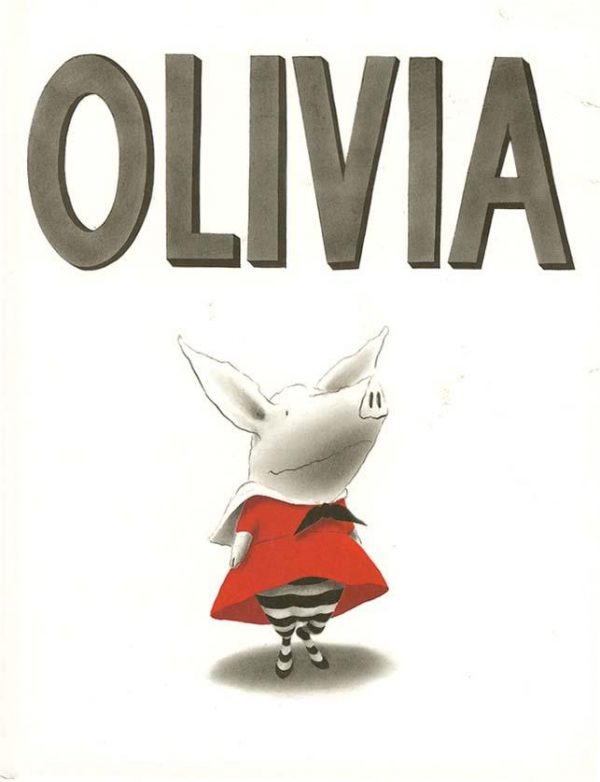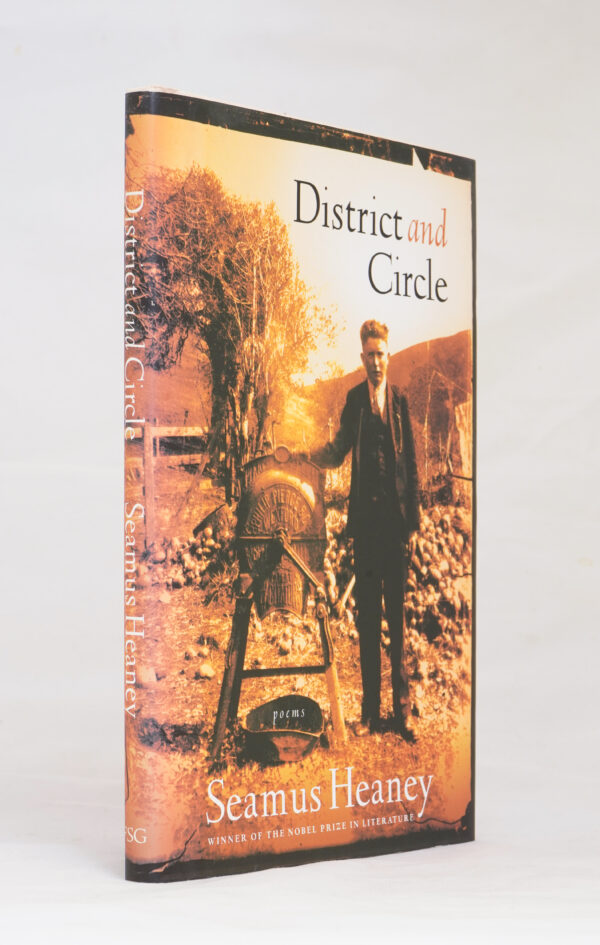
District and Circle
Heaney, Seamus First American edition. Fine in a fine dust-wrapper. PRESENTATION COPY from Heaney to Jonathan Galassi, president and publisher of FSG, and Heaney's editor, inscribed: "for Jonathan -/ in the circle/ and holding the line -/ with great affection/ Seamus/ 9 June 2006/ Union Square Café" on the title-page.- $1,450
- $1,450
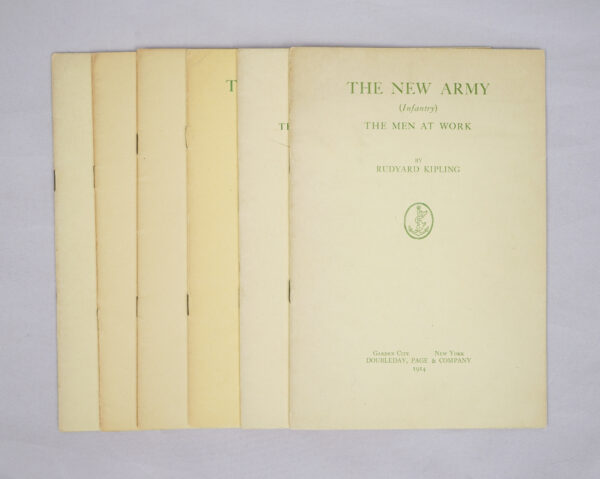
The New Army
Kipling, Rudyard Copyright edition, preceding the first appearance in book form. Stapled card-bound in six octavo parts ([I]: The Men at Work; II: The Quality of the Machine; III: Guns and Supply; IV: Canadians in Camp; V: Indian Troops; VI: A Territorial Battalion, and a Conclusion. Near fine. Then as now, no comprehensive copyright agreement obtained between the two largest anglophone book-markets: the U.K. and the U.S. As a British citizen -- Henry James enjoyed the best of both worlds -- Kipling could not publish works in America that were protected by copyright unless they were published in America first (no relation to the current administration's modus regendi). Thus Kipling and his agent Watt contrived to publish limited runs, sometimes as few as eight copies, with Doubleday in order to secure the American copyright while having the trade edition come out first in Britain. Thus these are the true first editions (see our other items in this category) of many of Kipling's stories in the 1910's and beyond. Based on articles Kipling wrote for the Daily Telegraph, these describe of training troops after Germany's invasion of Belgium in 1914.- $475
- $475
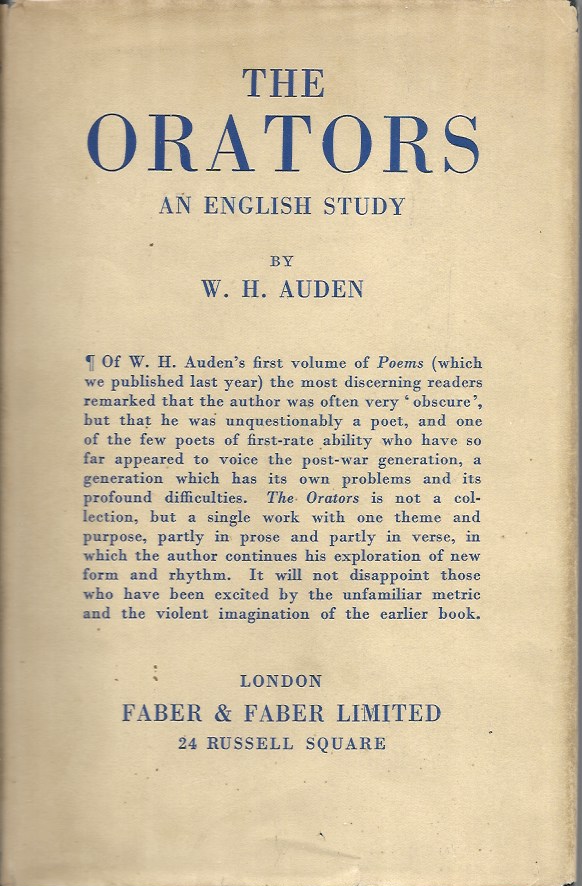
THE ORATORS, An English Study.
Auden, W. H. W.H. Auden. THE ORATORS, An English Study. Auden's third book of poetry, published in London, by Faber & Faber Limited, in 1932. The book is in very fine condition in an exceptionally nice dust jacket (see scan of front panel) with slight chipping at the top of the spine, and a small triangular chip on the rear panel. Neither chip affects any of the text. There were only 1,000 copies printed. This first edition is particularly important because it is the only time that it was printed in this original text. Auden reprinted it a number of times, beginning in 1933, but each subsequent printing had significant alterations and omissions. Conn [Bloomfield and Mendelson A3.]- $650
- $650
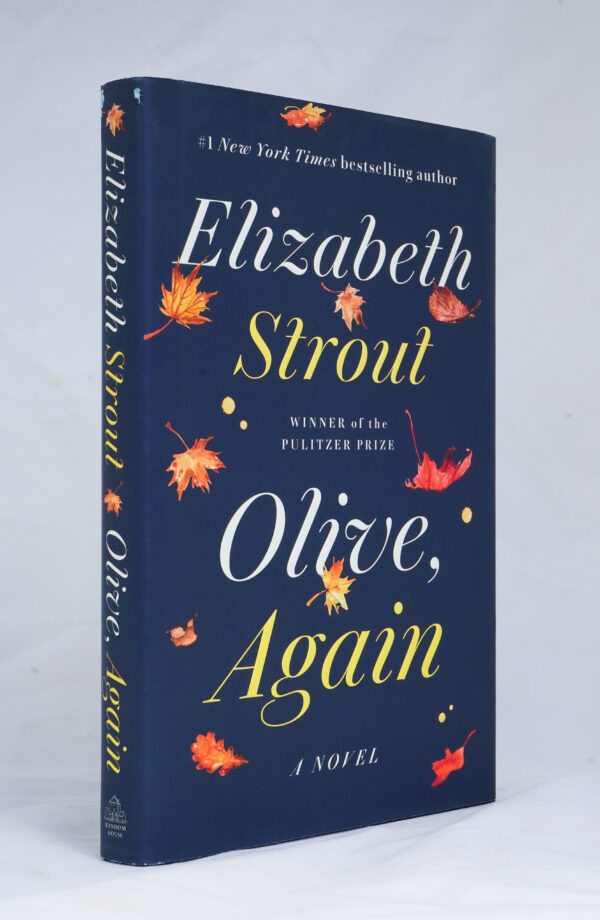
Olive, Again
Strout, Elizabeth First edition, first printing. The faintest of scuffs to the peripheries of the dust-wrapper (as is so common with this matte coated paper); else fine. Signed by Strout on the title-page. The sequel to Strout's volcanically popular Olive Kitteridge (Pulitzer, NBCCA; adapted into a mini-series starring Frances McDormand) and written in the same form: thirteen interwoven short stories bringing Olive through to her eighties in various situations in Crosby, Maine and its environs.- $114
- |
- $114
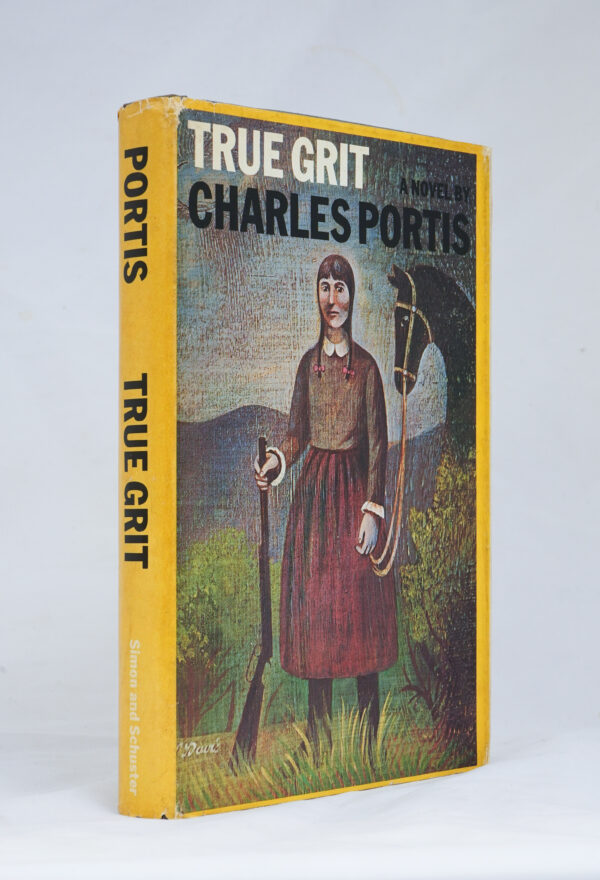
True Grit
Portis, Charles First edition, first printing (stated) in book form, after serialization in The Saturday Evening Post. Very good in a good dust-wrapper. With price-sticker residue to the front paste-down. Spine lovely and bright, unusually. The recollection of Mattie Ross of Dardanelle, Arkansas, who seeks vengeance for the killing of her Daddy, accompanied by the U.S. Marshal "Rooster" Cogburn. The basis of two acclaimed films: 1969's Kim Darby/John Wayne picture and 2010's Coen brothers picture, starring Hailee Steinfeld and Jeff Bridges.- $424
- $424
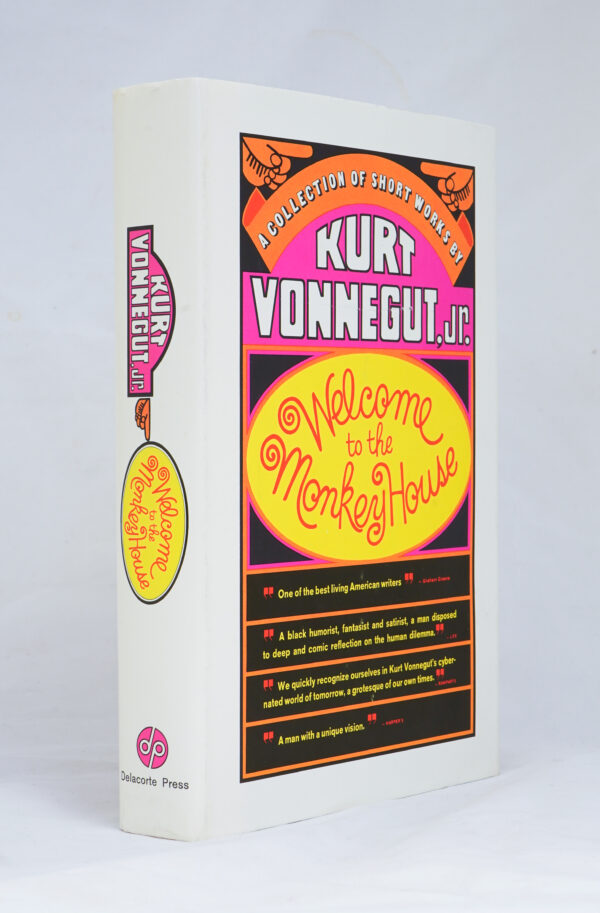
Welcome to the Monkey House
Vonnegut, Kurt, Jr. First edition, first printing ("First Delacorte printing"). A light scratch through the author's name and a small closed tear to the rear of the dust-wrapper; else fine (unusually bright). Vonnegut's off-kilter Orwellian surrealism is in full late-60's flower (printed in August of 1968) in his second collection of short works. The dust-wrapper was designed by the legendary Paul Bacon (who also designed the wrapper of Slaughterhouse-Five).- $848
- $848
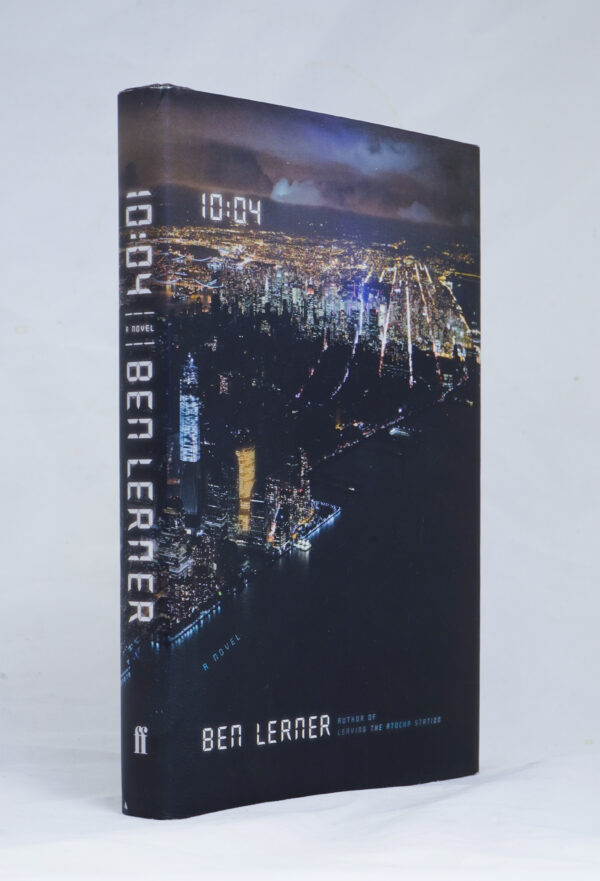
10:04. A novel
Lerner, Ben First edition, first printing. Faintest bumps to the dust-wrapper, else fine. Signed on the title-page by Lerner. Written in the aftermath of Hurricane Sandy, 10:04 sees a Lerner-like protagonist navigating life in death in a time of new uncertainty. Hari Kunzru in his Times review called it "frequently brilliant." Shortlisted for the Paris Review's Folio Prize. (There are several variants of the dust-wrapper (the present item featuring a reversed photograph looking northward from south of Manhattan), as well as another 2014 New York edition published by McClelland & Stewart; outs would seem to be the true first.)- $144
- $144
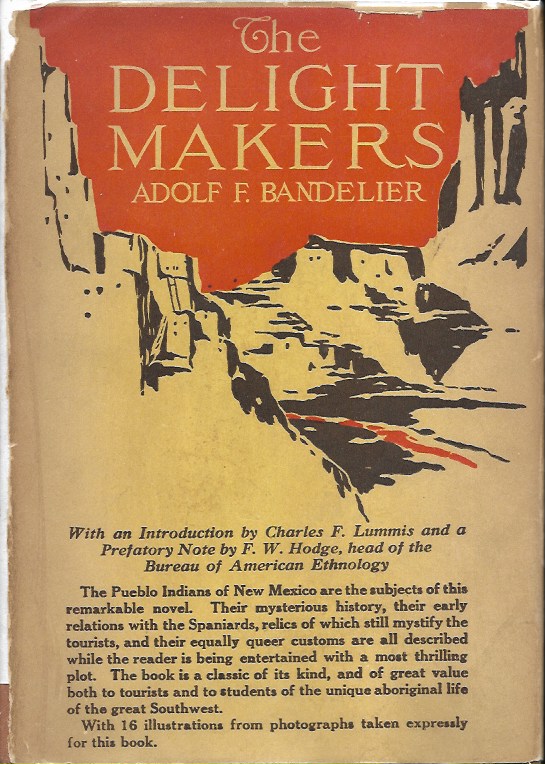
THE DELIGHT MAKERS.
Bandelier, Adolf F. THE DELIGHT MAKERS By Adolf F. Bandelier. A strikingly beautiful copy with both the book and the rare dust jacket in fine condition. There are no markings in the text, and no ownership notations. Published by Dodd, Mead in New York in 1918. 490 pages following xvii pages of introductory matter. With a photographic frontispiece portrait of the author and 16 photographic illustrations taken specifically for this edition.- $345
- $345
![Theorie de la Perspective [with:] Nouvelle Theorie du Melange des Coulêurs. Tirée de l'Optique de M. Newton . [Paris](https://rarebookinsider.com/wp-content/uploads/2020/11/30623450518-600x853.jpg)
Theorie de la Perspective [with:] Nouvelle Theorie du Melange des Coulêurs. Tirée de l’Optique de M. Newton . [Paris, ca 1757]
LACAILLE, Nicolas-Louis, Abbé de (1713-1762) Folio (370 x 240 mm), ff [10], with one loose folded sheet of tables and one partsheet of astronomical observations (see below), ink on paper, with numerous diagrams and tables, text and tables with extensive revisions and corrections; in very good condition, unbound. A detailed manuscript on perspective and optics, with extensive tables for calculating the distance of objects, probably used in Lacailles courses on mathematics which he taught at the Collège Mazarin in Paris. The work begins with the Théorie de la Perspective. This is followed by Pratique de la Perspective. Five full-page and detailed tables follow, with the vertical columns titled Distances de lObject au Plan du Tableau, and the horizontal columns titled Distances de lObject au plan Horizontal ou au plan Vertical, containing 10,000 calculations. The next section is titled Regles pour trouver La Perspective des Objets dont les faces sont inclinées au Plan du Tableau, accompanied by another extensive table with 1700 calculations. The final perspective section is titled Sur Le Point de vuë, et le Lieu de loeil. The second part is devoted to Newtons theory of colours, and seems to be based upon the French edition of Brook Taylors work on perspective. The French translation appeared in Amsterdam in 1757 and was titled Nouveau Principes de la Perspective Linéaire, which contained Essai sur le Mêlange des Couleurs, par Newton. However, LaCailles text is not a translation of that of Taylors, and in fact a radical reworking of the basic geometric principles of perspective. The tables are unique, the result of a massive effort of computation, one of Lacailles noted skills. Many of these techniques are related to his observational skills in astronomy and in calculating astronomical positions and distances. The small astronomical manuscript relates to observations he made at the Mazarin: Par un milieu entre six observations dun coté deduites au 1 Jan 1748 du egard a la observation eu à la precéssion. LaCaille was an astronomer who was a prodigious observer and calculator, having observed over 10,000 stars in the Southern hemisphere, and named 14 of the 88 constellations. Initally he was assistant to Jacques Cassini and participated in a series of surveying projects, and in 1739 in remeasuring the arc of the meridian. Appointed professor of mathematics at the Collège Mazarin, he built his own observatory where he carried out astronomical observations. In 1752 he made an astronomical expedition to the Cape of Good Hope, where he built an observatory and carried out a prodigious series of observations, including the discovery and cataloguing of 42 nebulae. Lalande stated that he made more observations and calculations than all previous astronomers combined. Upon his return to Paris in 1754 he resumed his post and teaching duties at the Mazarin. His students included the great chemist Antoine Lavoisier- $7,500
- $7,500
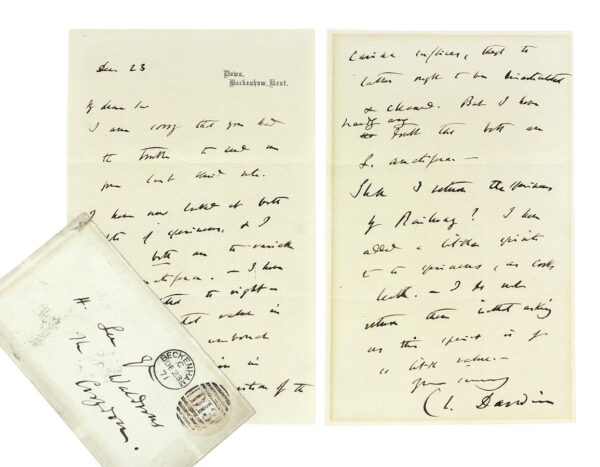
Autograph letter signed to biologist Henry lee, concerning the identification of species of barnacles, dated 23 December 1871.
DARWIN, Charles (1809?Äì1882) DARWIN, Charles (1809?Äì1882). Autograph letter signed to biologist Henry lee, concerning the identification of species of barnacles, dated 23 December 1871. Down, Beckenham, Kent, 23 December, 18718vo (2 pages on a single folded sheet, 200 x 259 mm) on printed letterhead Down, Beckenham, Kent?Äô, in ink, with original envelope addressed in Darwin?Äôs hand, stamped and postmarked; in very good condition, in a quarter-leather folding case. $18,500A fine and fascinating letter (with the original addressed envelope; these rarely survive), written in Darwin?Äôs scientific maturity but reverting to his early expertise in the anatomy of barnacles. Barnalces were the subject of his first major scientific monograph, published in two volumes by the Ray Society in 1851, 1854 (A monograph of the sub-class Cirripedia, with figures of all the species. The Lepadid? ; or, pedunculated cirripedes . ). Darwin undertook the anatomical investigation of barnacles both as a result of specimens he collected during the Beagle voyage and also to demonstrate his mastery of detailed anatomical and taxonomic investigation. His work established the nomenclature and classification criteria that became standard up to this day.The letter concerns specimens of gooseneck barnacles submitted to Darwin by Henry Lee for classification. Darwin replies in detail with his characteristic attention and kindness to any serious scientific correspondent, even while he was engaged in correcting proofs for the sixth edition of the Origin of Species. Darwin conducted microscopic anatomical examinations of Lee?Äôs specimens and writes: ?ÄòI have now looked at both lots of specimens, & I think both are the variable L. ?anatifera.?Äî I have disarticulated the right-hand scutal valve in both & the umbonal teeth are plain in both. This with position of the carina suffices, though the latter ought to be disarticulated and cleaned. But I have hardly any doubt that both are L. ?anatifera . ?Äô.?ÄòDarwin's work on barnacles (Cirripedia), conducted between 1846 and 1854, has long posed problems for historians. Coming between his ?transmutation notebooks ?and the ?Origin of species, it has frequently been interpreted as a digression from Darwin's species work. Yet when this study is viewed in the context of Darwin's earlier interests, in particular his studies of marine invertebrates carried out during his student days in Edinburgh and later on board the ?Beagle, the ?monograph on the Cirripedia ?seems less anomalous. Moreover, Darwin's study of cirripedes, far from being merely a dry, taxonomic exercise, was a highly theoretical work that addressed several problems at the forefront of contemporary natural history. Treating a group of organisms of considerable interest to mid-nineteenth century naturalists and approaching their classification using the most recent methods available, Darwin was able to provide a thorough taxonomic study that has remained a standard work in cirripede morphology and systematics. For Darwin personally, the barnacle work perfected his understanding of scientific nomenclature, comprising both theoretical principles and technical facility with the methods of comparative anatomy. It also provided him with an empirical means of testing his views on the species question (Crisp 1983) ?Ä Darwin's evolutionary interpretation of the meaning of classification explains why he readily adopted embryology as a methodological tool for revealing homologies?Äô (Cambridge University, Darwin On-line).Darwin exchanged several letters with Henry Lee.Henry Lee, naturalist, succeeded John Keast Lord (1818?Äì1872) as naturalist of the Brighton aquarium in 1872, and was for some time a director there. While at the aquarium he instituted important experiments on the migration of smelts, the habits of herring, and the nature of whitebait and crayfish. His Aquarium Notes (1875) for the use of visitors, was able and attractive. Lee was also author of The Octopus (1874), The White Whale (1878), Sea Fables Explained (1883), and Sea Monsters Unmasked (1883). The last two works were part of a series of handbooks issued in connection with the International Fisheries Exhibition in London in 1883. He also published The Vegetable Lamb of Tartary: a Curious Fable of the Cotton Plant (1887).?ÄòLee was also an energetic collector of natural history specimens, and a skilful worker with the microscope. On 5 April 1866 he was made a fellow of the Linnean Society, and he was founder of the Croydon Microscopical and Natural History Club established on 6 April 1870. He was also a member of the Geological and Zoological societies of London?Äô (ODNB).Darwin Correspondence Project n 8118B (partial transcript only)- $18,500
- $18,500
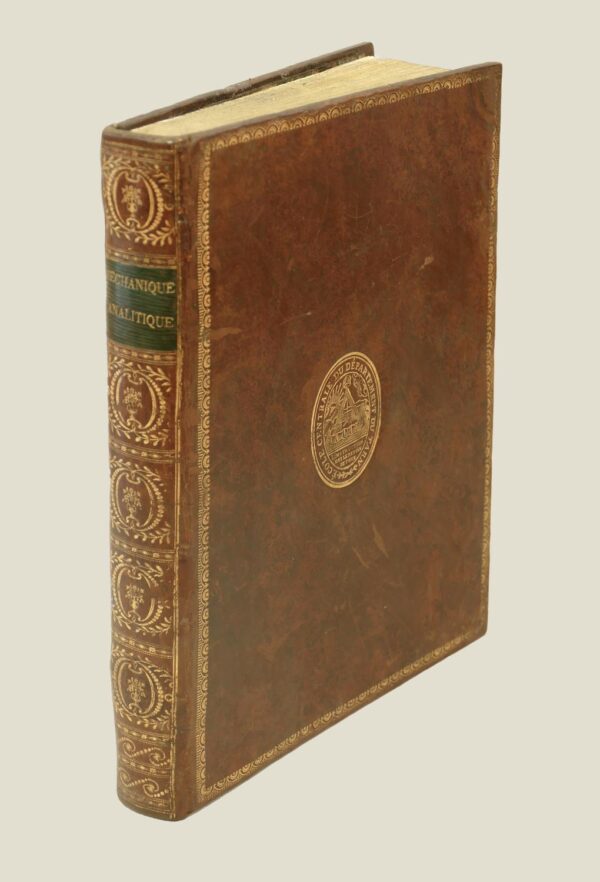
M? chanique analytique.
LAGRANGE, Joseph Louis (1736?Äì1813) LAGRANGE, Joseph Louis (1736?Äì1813). M? chanique analytique. Paris, La Veuve Desaint, 17884to (256 x 195 mm), pp xii, 512; a fine copy in contemporary French calf, gilt neoclassical panels on sides and gilt panels with wreaths and urns on spine.First edition of Lagrange's masterpiece, which has been described as ?Äòperhaps the most beautiful mathematical treatise in existence.?Äô This is the scarcest of Lagrange's major works.?ÄòIt was reserved for Lagrange to mould theoretical mechanics into a system, and by combining the principle of virtual velocities with D'Alembert's Principle, to derive fundamental mechanical equations which describe the motion of any system of bodies. These important results were set forth in Lagrange's masterpiece, the M? chanique Analytique (Paris, 1788), which laid the foundations of modern mechanics, and which occupies a place in the history of the subject second only to Newton's Principia. The two works differ in one essential respect, namely, whereas Newton derives his results purely geometrically, or synthetically, with the aid of figures, Lagrange, dispensing with diagrams, treats the subject in an entirely analytical manner. He followed the example of Euler in his analytical treatment and his efforts to find the most comprehensive formulae which should enable as many particular cases as possible to be treated on the same lines. In this sense Lagrange's work has been described by Mach as one of the greatest contributions to the economy of thought?Äô (Wolf, History of science. in the eighteenth century, pp. 69-70).Provenance: gilt arms of the ?âcole centrale du d? partement du Tarn on upper cover and stamp of ?âcole sup? rieure de commerce et d?Äôindustrie, Bordeaux, on title and one other leafDibner 112; En fran?ßais dans le texte 179; Horblit 61; Norman 1257; Parkinson p 216- $15,000
- $15,000
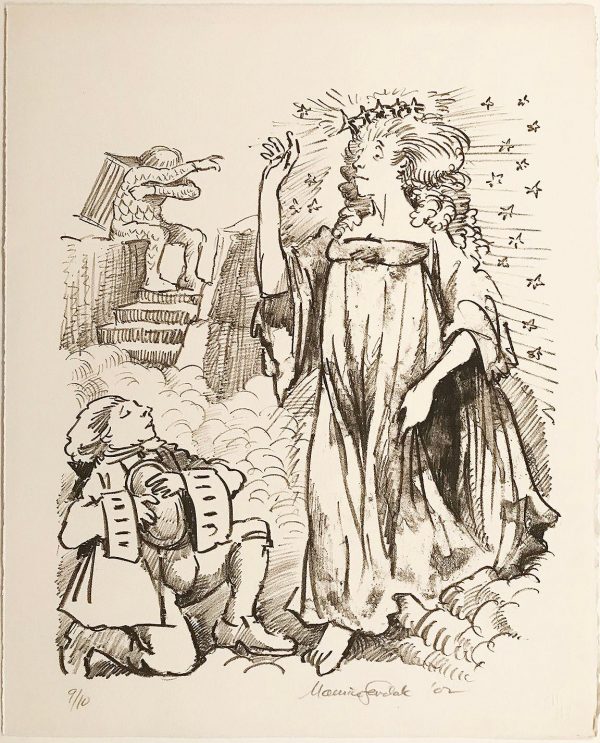
Magic Flute: Queen of the Night
SENDAK (Maurice) MAGIC FLUTE. 1980, original lithograph on stone, each drawn and fully signed in pencil by the artist Maurice Sendak, each example numbered in pencil lower left 9/10, dated 02 indicating when signed by Sendak but actually printed twenty-two years earlier by Ken Tyler at Tyler Graphics Ltd (New Bedford NY) on partially deckled-edged rag paper with the Tyler blind stamp insignia in lower right corner: Frank Corsaro (Producer of this version) as Queen of the Night 15-1/4 x 12-3/8 inches- $7,500
- $7,500
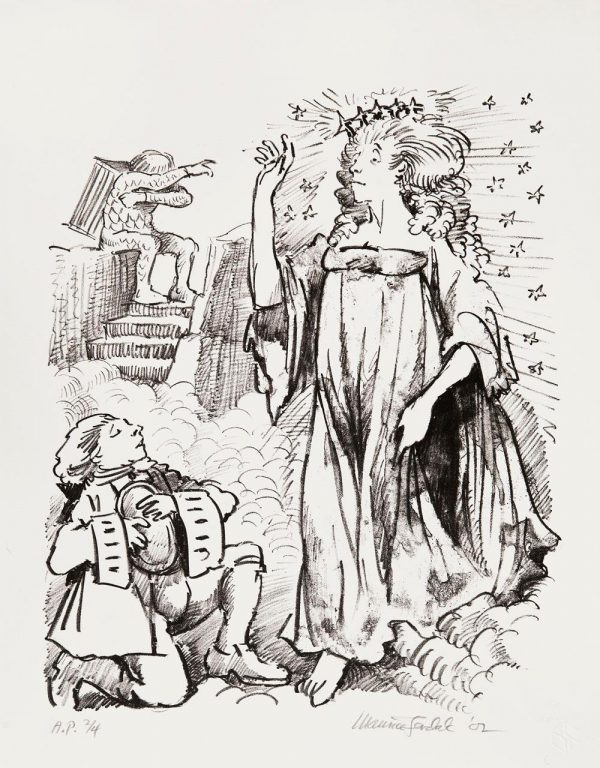
Three Boys (Child Spirits) and Mozart
SENDAK (Maurice) SENDAK (Maurice0: MAGIC FLUTE. 1980, original lithograph on stone, each drawn and fully signed in pencil by the artist Maurice Sendak, each example numbered in pencil lower left 9/10, dated 02 indicating when signed by Sendak but actually printed twenty-two years earlier by Ken Tyler at Tyler Graphics Ltd (New Bedford NY) on partially deckled-edged rag paper with the Tyler blind stamp insignia in lower right corner: Three Boys (Child Spirits) and Mozart. Captioned Dragon Act 1 Scene 1 / Temple No. 1 Measures 15 x 12-1/4 inches- $7,500
- $7,500
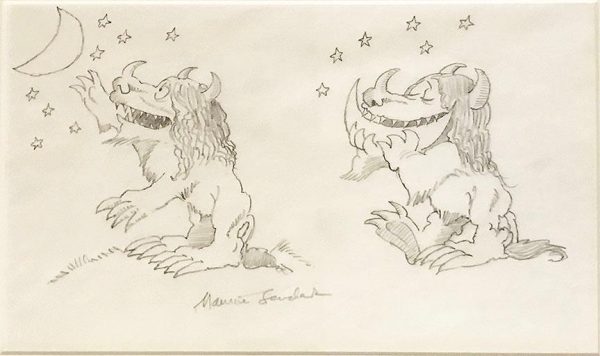
Metreon: Watermelon Moon
SENDAK (Maurice) SENDAK (Maurice): METREON: Wild Things Watermelon Moon . 1996 Metreon Wild Thing Transformation Original Pencil study for Metreon installation in San Francisco Measures 5 x 9-3/4 inches on larger paper Signed in full at bottom center image of a Wild Thing Eating a Watermelon Moon Reference: Schiller Sendak Abrams 2013 (p. 74)- $12,500
- $12,500
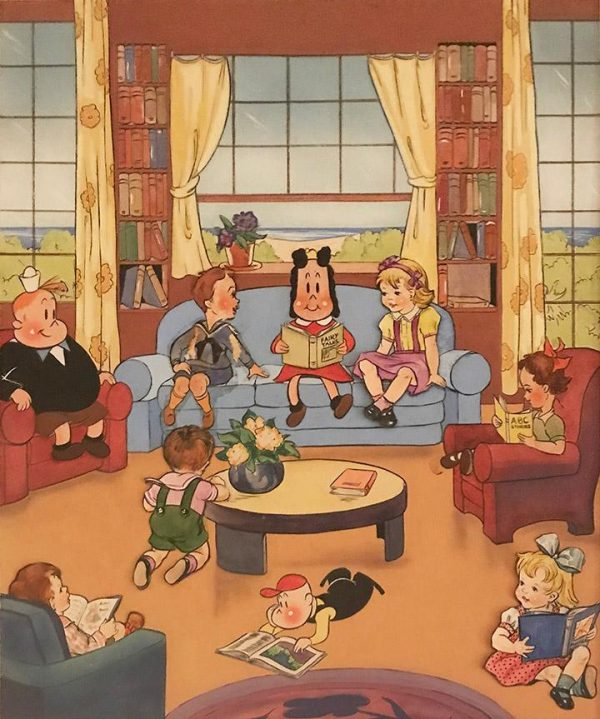
Little Lulu and Friends
BUELL (Marjorie H "Marge")) BUELL (Marjorie H Marge), attributed [19041993] Little LULU with Friends. 1947. Watercolor and mounted cut-out figures. Cover design for McLoughlin Bros catalogue: Childrens Books 1947. The image was used for the last catalogue published by the firm. Measures 14-11/16 x 12-1/2 inches- $5,000
- $5,000
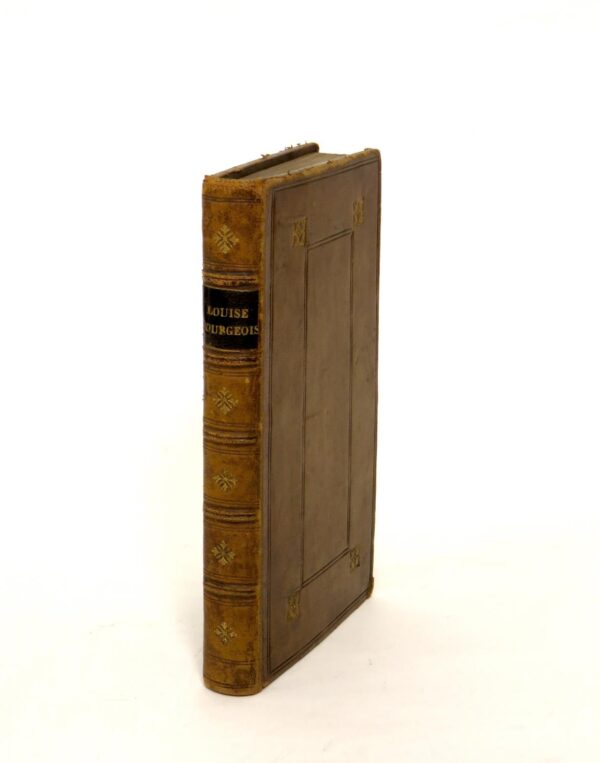
Observations diverses sur la sterilité, perte de fruict, fecondité, accouchements, et maladies des femmes et enfants nouveaux naiz .
BOURGEOIS [BOURSIER], Louise (1563-1636) 8vo (167 x 95 mm), ff [12] 12 [recte 3, without terminal blank], with fine engraved allegorical title and two engraved portraits (the author and Marie de Medici, Queen of France); a fine copy, in nineteenth-century French brown morocco, panelled in blind with gilt corner ornaments, spine gilt, slightly worn. First edition, first issue, very rare, of the first obstetrics book written by a woman to be published, and a work that founded obstetrics as a science. It was one of the most popular and influential textbooks of its day, and was credited by Jean Astruc with greatly advancing French midwifery. 'She was one of the pioneers of scientific midwifery; her Observations was the vade mecum of contemporary midwives' (Garrison and Morton).Louise Bourgeois became interested in midwifery after the birth of her first child, with the result that she studied medicine and obstetrics practice under her barber-surgeon husband, Martin Boursier, and his teacher the great Ambroise Paré. The guild of midwives tried to oppose her application for a licence, fearing her increasing reputation amongst Paré's circle of surgeons. Their opposition was of no avail, however, and she was summoned to attend the confinement of Marie de Medici, Queen of France, for the birth of the future Louis XIII. She thus became midwife to the French court for 27 years, and delivered all the children of Marie de Medici. The death by puerperal sepsis of the child of the Duchess of Orléans, the princess Marie de Bourbon-Montpensier, in 1627 brought an end to her reign at the age of 64, and as a result Louis XIV required that at all future royal births a surgeon should be present.Bourgeois drew on the practice of Paré and Guillemeau. She 'advocated the induction of premature labor for contracted pelvis and gave original descriptions of prolapsed umbilical cord and face presentation and their management' (Speert).The collation of this work is a8 e4 A-P8, Q4, with I8 cancelled, with numerous errors in foliation and two in signatures (D3 and E3); the work was reset correcting these errors in the later issue, which can be distinguished by having Q4 blank (or absent)Provenance: presentation inscription on front flyleaf 'Au Docteur L. Santé Amicitior memoria sacrum Langres 1915 Paris [infinity sign] Georges Grappe'; Georges Grappe (1897-1947) was an art historian and curator of the Rodin museumGarrison and Morton 6145; Cutter and Veits pp 73-76; Speert Iconographia gyniatrica pp 72-73; Krivatsy 1625 (imperfect); Waller 1365; OCLC records NLM, UCLA, Yale, Kansas, Johns Hopkins, Duke, Philadelphia College of Physicians, and UBC for North America (both issues, mostly the second)- $9,500
- $9,500
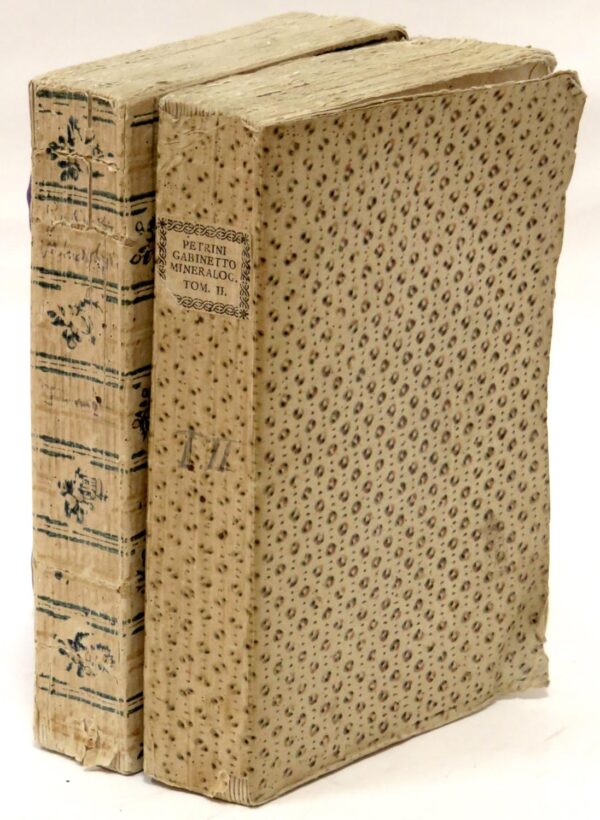
Gabinetto mineralogico del Collegio Nazareno descritto secondo i caratteri esterni e distribuito a norma de’ principi constitutivi.
PETRINI, Giovanni Vincenzo] (1725-1814) Two vols, 8vo (218 x 145 mm), pp LII 384 [2, errata and blank]; XXXIX [1, blank] 387 [1, blank]; some faint marginal waterstaining to first leaves of second vol, some corners of prelims crumpled, really a very attractive, fresh, and unpressed copy in contemporary Italian patterned boards (differing but both vols with the same provenance), slightly worn. First edition of this extensive catalogue of the mineralogical museum in the Collegeo Nazareno in Rome, founded by the author, Father Petrini and arranged by Scipione Breislak.'Rare. Extensive descriptive collection catalog of the mineral specimens held in at Nazareno College in Rome at the end of the 18th century. The preliminaries of the first volume provide some history of the formation of the collection and a synopsis of the new chemistry of Lavoisier. The catalog then commences, classifying the specimens into a standard structure of salts, earths, bitumens and flammable bodies, and metals. Volcanic objects and fossils are given their own classifications and are treated at the end of volume two' (Curtis Schuh, Biobibliography of Mineralogy online). The organiser of the collection, Scipione Breislak (1750-1826) was '. one of the founders of volcanology in Italy, Breislak was the first to determine that basaltic rocks were of extrusive origin; he also emphasised that the tufaceous deposits of Campania originated under water, and he reconstructed the evolution of Vesuvius' (DSB). He was the author of Introduzione alle Geologia (Milan, 1811).'Antiquarians and polymaths in the seventeenth and eighteenth centuries pursued del Riccio's interest in the geological and geographic origins of marble with even greater scientific rigor. The secretary of the papal nephew Francesco Barberini, Cassiano del Pozzo, assembled a vast collection of drawings of the objects, buildings, and other material remains of the ancient world. This corpus of drawings, known as the paper museum (museo caraceo), included a catalogue of stones painted on paper. Dal Pozzo worked with the Venetian painter Jacopo Ligozzi and the director of the opificio fiorentino, Matteo Nigetti, in painting and compiling the samplings. Painted compilations such as Dal Pozzo's became the actual marble-sample panels of the eighteenth century: to this end Father Giovan Vincenzo Petrini (1725-1784) founded a mineralogical museum in the Collegio Nazareno in Rome' (Radical Marble, Architectural Innovation from Antiquity to the Present, J. Nicholas Napoli and William Tronzo, eds)Provenance: early ownership inscription 'C. Guicciardi' on both endleavesWard and Carozzi 1754; OCLC records Smithsonian, Chicago, Illinois, Oklahoma, McGill, and Cornell in North America- $3,250
- $3,250
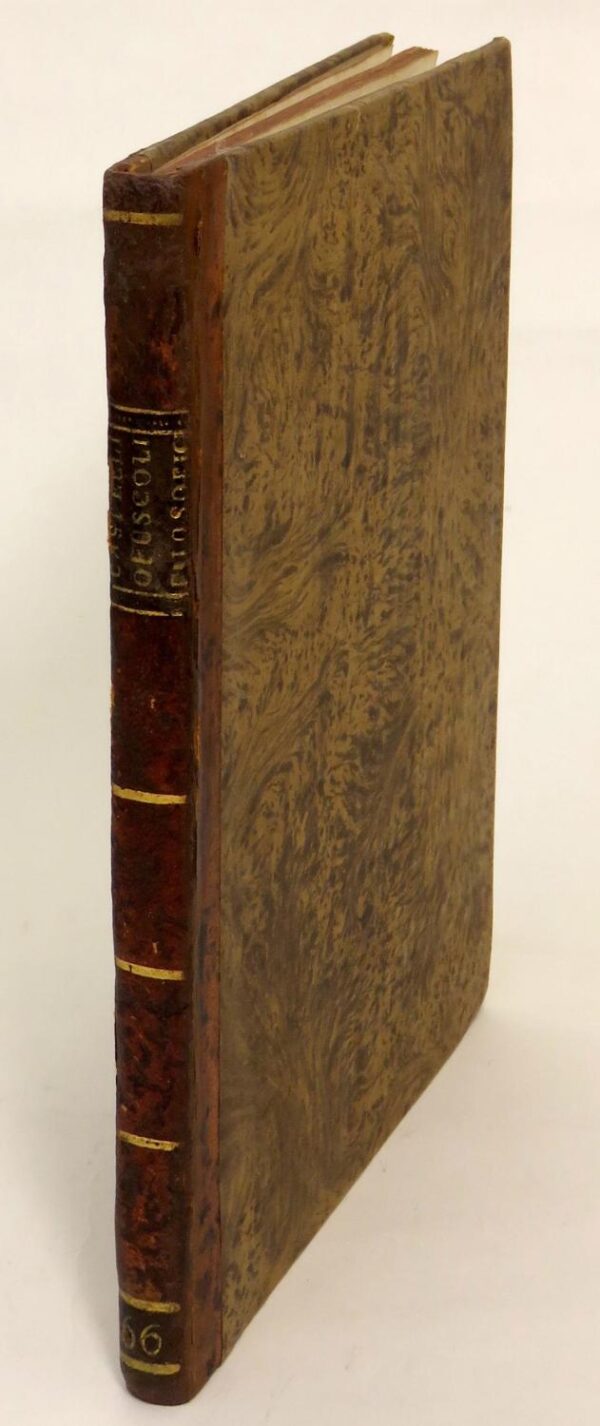
Alcuni opuscoli filosofici . Al serenissimo, e reverendiss. principe il sig. cardinale de’ Medici.
CASTELLI, Benedetto (1578-1643) 4to (224 x 160 mm), pp [viii] 79 [1, blank], title with large vignette of the arms of the Medici dedicatee, engraved by Pietro Tedeschi, and five woodcut optical diagrams in text; a fine copy on thick paper, unpressed, in nineteenth-century calf-backed boards, minor wear to spine. First edition of this rare posthumous publication, containing Castelli's most important contributions to the field of optics. The text comprises miscellaneous pieces, including the first publications of two letters to Galileo (dated 27 June 1637 and 2 August 1638, pages 47-79) detailing experiments on the absorption and transmission of radiant heat by differently coloured surfaces.'Castelli's optical investigations were continued in a treatise sent to Giovanni Ciampoli in 1639 and published in 1669 [in the present work]. Included are many observations and conclusions with respect to the persistence of optical images, by which Castelli explained the perception of motion, the illusion of forked tongues in serpents, and other phenomena. In the same treatise he recommended the use of diaphragms in telescopes to impede transverse rays, anticipating Hevelius. His discussions of the camera obscura, the inversion of images on the retina, and of cataract (from which Galileo had recently lost his sight), although less novel, are not without interest.'More celebrated is Castell's discussion of heat in a series of letters to Galileo (1637-1638) and particularly his experiments with the absorption of radiant and transmitted heat by black and white objects. Two of these letters, in which the pursuit of experimental science is even more clearly described than in Galileo's work on bodies of water, were published in 1669 [in the above]' (DSB).In a treatise on the preservation of grains (pp 39-46) Castelli suggests keeping wheat in sealed containers so that pathogens are kept out, anticipating later discoveries by Francesco Redi in microbiology and the discrediting the theory of spontaneous generation.Carli and Favaro 322; Riccardi I 291 n 3; OCLC records Cal Tech, Huntington (Burndy), Yale, American Philosophical Society, Oklahoma, Wisconsin, and UC Berkeley for North America- $16,500
- $16,500
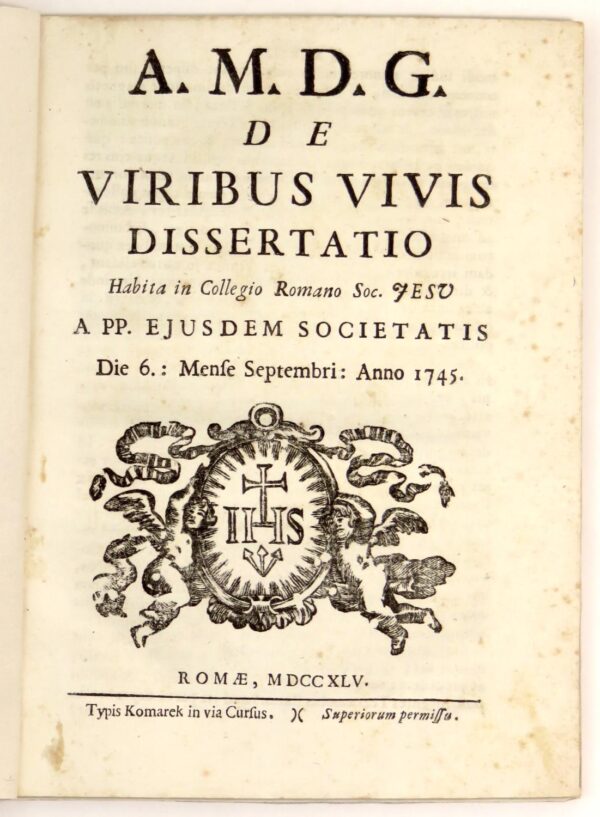
De viribus vivis dissertatio .
BOSCOVICH, Ruggero Giuseppe] (1711-1787) 4to ( 221 x 164 mm), pp XLIX [1, blank], with folding engraved plates; a very faint occasional marginal spotting, a very good copy in plain wrappers.First edition, first issue of Boscovich's earliest published work on his dynamic point theory, and which was the precursor to his great Philosophiae naturalis theoria redacta ad unicam legem virium in natura existentium (1758), a work considered as the 'birth of atomic physics' and praised by Faraday, Maxwell, and Heisenberg. Boscovich stated in the Philosophiae naturalis theoria that his work originated in this 1745 publication.Boscovich's dynamic point theory 'was not only the first general mathematical theory of atomism . but more specifically it was the first scientific theory: to treat all the ultimate constituents of matter as identical; to employ finite numbers of point particles; to eliminate Newtonian mass as a primary quantity, substituting a kinematic basis; to postulate a relational basis for the mathematical treatment of inertia and of all space and time observations; to propose to derive all physical effects from a single law; to eliminate the scale-free similarity property of the Newtonian law, introducing natural lengths into continuous laws so as to determine unique equilibrium positions and other scale-fixed properties; to employ a power series to represent an observable.' (L. L. Whyte in Roger Joseph Boscovich . Studies of his life and work, London, 1961).'The Theory of Natural Philosophy is now recognized as having exerted a fundamental influence on modern mathematical physics . As the title of his book implies, he considered that a single law was the basis of all natural phenomena and of the properties of matter; that the multiplicity of physical forces was only apparent and due to inadequate mathematical knowledge' (PMM).Boscovich's 'heterodoxy in mechanics began to be apparent at least as early as 1745, when he published an important discourse on the subject of living force (vis viva) . This discourse contained the first statement of Boscovich's universal force law.'That law was inspired partly by Leibniz's law of continuity and partly by the famous thirty-first query with which Newton concluded the fourth edition of his Opticks. There Newton raised speculatively the question whether there might not exist both attractive and repulsive forces alternately operative between the particles of matter. From this idea Boscovich proceeded by way of an analysis of collision of bodies to the enunciation of a "universal law of forces" between elements of matter, the force being alternately attractive or repulsive, depending upon the distance by which they are separated. As that distance diminishes toward zero, repulsion predominates and grows infinite so as to render direct contact between particles impossible. A fundamental role is played by the points of equilibrium between the attractive and repulsive forces. Boscovich called such points "boundaries" (limes, the Latin singular). Some of them are points of stable equilibrium for the particles in them and others are points of unstable equilibrium. The behavior of these boundaries and the areas between them enabled Boscovich to interpret cohesion, impenetrability, extension, and many physical and chemical properties of matter, including its emission of light.Extended description upon requestThere are two issues of this publication, an academic one as here, and a commercial one, the latter containing a differing imprint and also naming Boscovich as the author. A comparison of the two makes clear that both were printed from the same standing type, apart from the title page. The commercial issue has the imprint 'Sumptibus venantii Monaldini bibliopole', and also a different title ornament.Manuscript corrections to the text on pages V, IX, and XXXIX, as in the BSB copyRiccardi I.1 174 n 21; Sommervogel I 1832 n 22; OCLC records Huntington, Smithsonian, American Philosophical Society, Harvard, Princeton, and Brown for North- $9,000
- $9,000
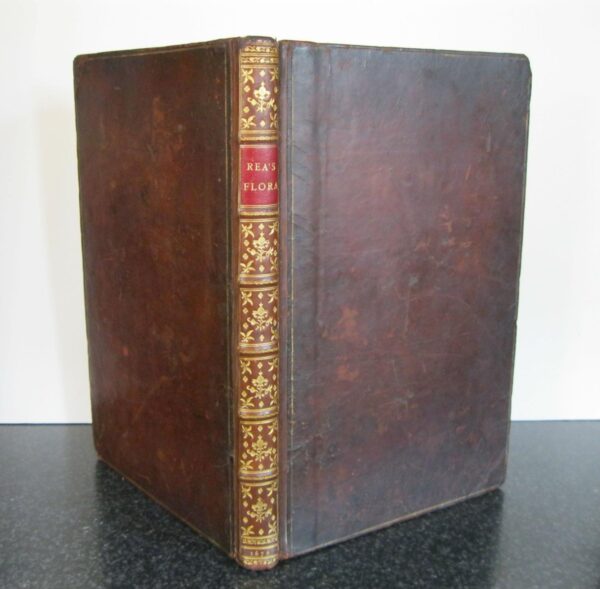
Flora: Seu, DeFlorum Cultura. Or a Complete Florilege, Furnish with All Requisites Belonging to a Florist.
Rea, John Brown call, re-backed. Engraved title-page and 16 (garden) plans on 8 plates. Sales receipt dated 1934 tipped onto front endpaper. Bookplate of former owner on front paste-down. Intermittent light imperfection (spotting, light dampstaining (not offensive), age toning to page perimeters, etc. Size: 4to - over 9¾" - 12" tall- $1,800
- $1,800
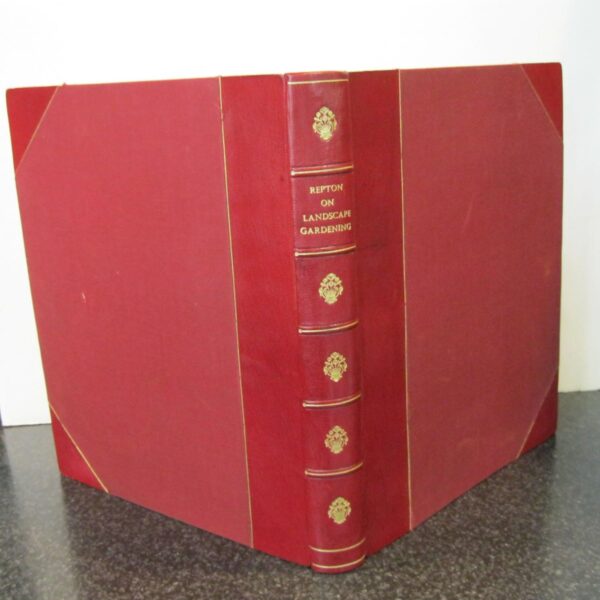
Observations on the Theory and Practice of Landscape Gardening
Repton, Humphry 1/2 maroon morocco, maroon cloth. Complete with all plates - several with overlays. Bookplate on front paste-down and former owner's name and date in pencil on front endsheet. An exceptional copy of this seminal work on landscape architecture. Size: Folio- $10,000
- $10,000
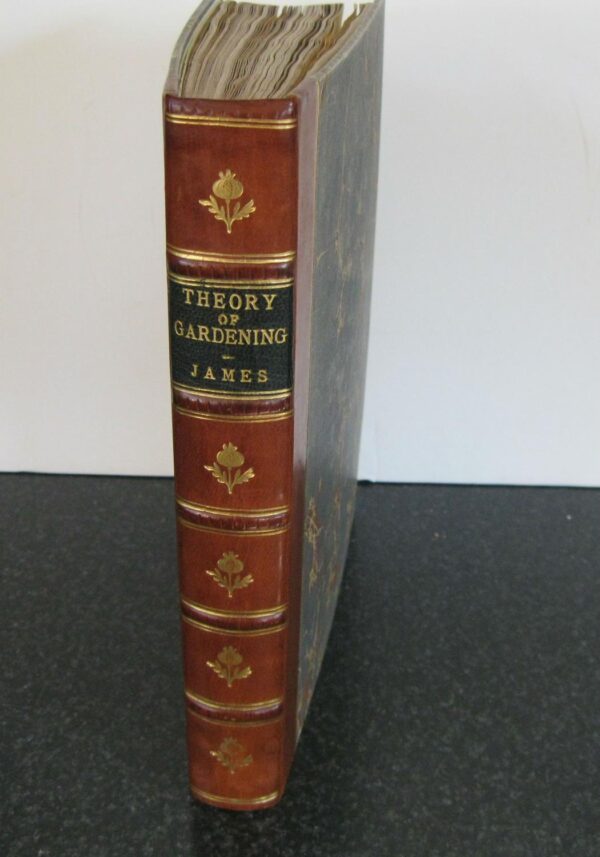
The Theory and Practice of Gardening: Wherein is Fully Handled All That Relates to Fine Gardens, Commonly Called pleasure-Gardens, Groves, Bowling–Greens, Etc.
James, John (Trans.) Handsomely bound in 1/4 brown morocco, marbled boards, gilt ornaments in panels. First English Translation. Complete with 32 folding and double-page plates. Cuts-in-text. Some minor spotting and age-toning to page perimeters. Bookplate of former owner on front paste-down. Very scarce. Size: 4to - over 9¾" - 12" tall- $2,750
- $2,750
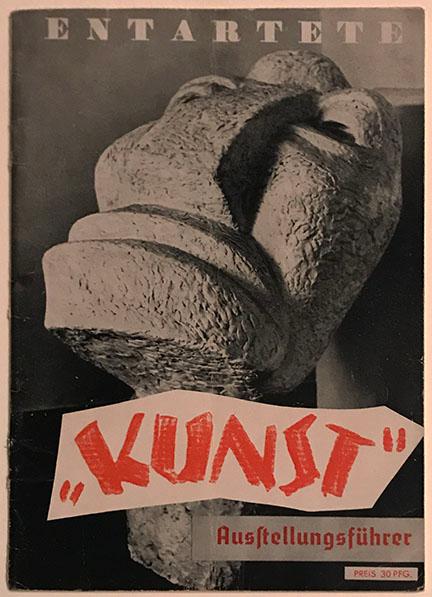
Entartete Kunst. Austellungsführer
KAISER (Fritz) (Degenerate Art). KAISER (Fritz): Entartete Kunst. Austellungsführer. Führer durch die Austellung Entartete Kunst zusammengestellt von der Reichspropagandaleitung, Amtsleitung Kultur. Berlin: Verlag fur Kultur und Wirtschaftswerbung [1938]. 8vo., 30[2] pp.; printed pictorial wrappers, stapled spine (vertical crease where once folded in the middle, light soiling, otherwise in very good condition). The cover illustration The New Man by Otto Freundlich. This illustrated guide, written by Fritz Kaiser, an official in the Reich Propaganda Ministry, was issued as a souvenir of the vicious and defamatory 1937 show of modern art.- $1,200
- $1,200
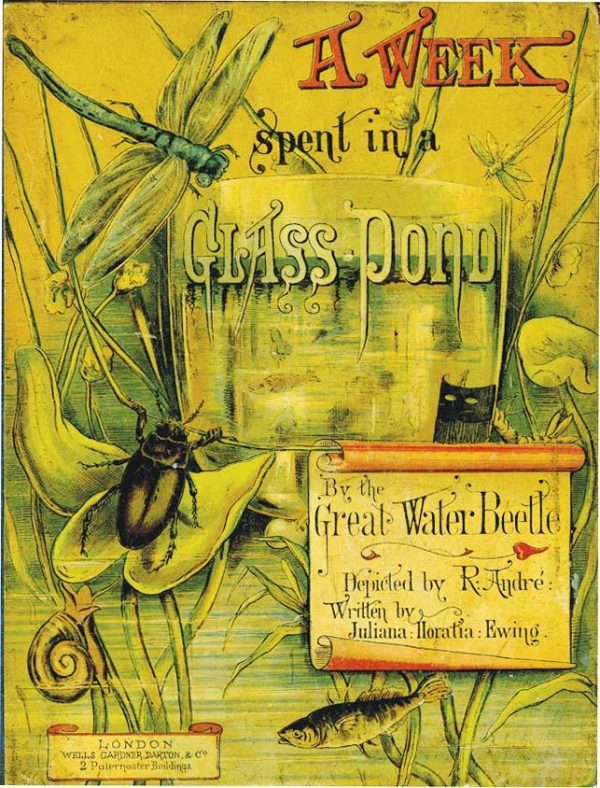
WEEK SPENT IN A GLASS POND
EWING, JULIANA HORATIA (ANDRE,R.)illus. A WEEK SPENT IN A GLASS POND by the Great Water Beetle by JULIANA HORATIA EWING. London: Wells Gardner Darton, no date [1883]. 4to (7 1/4 x 9 1/8"), cloth backed pictorial boards, 32p., edges rubbed and some finger soil, VG+. Beautifully illustrated by Andre with detailed chromolithographs on every page plus there is a stunning pictorial cover. Osborne p.984.- $440
- $440
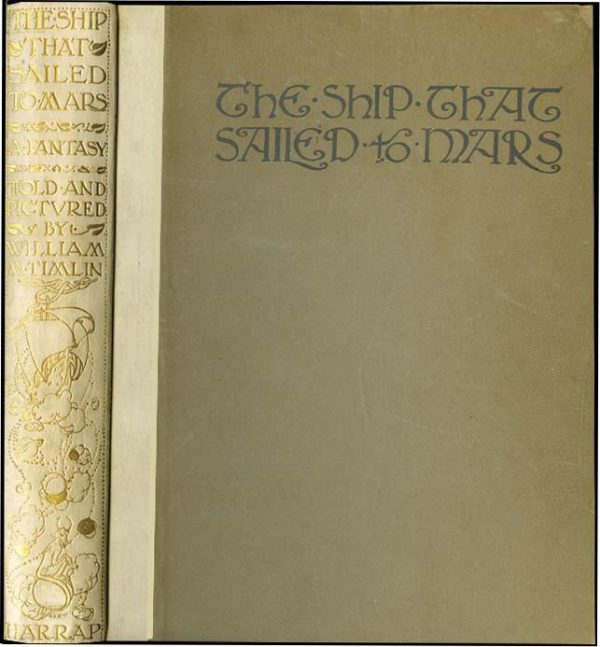
SHIP THAT SAILED TO MARS
TIMLIN, WILLIAM TIMLIN,WILLIAM. THE SHIP THAT SAILED TO MARS. London: Harrap, no date [1923]. Large 4to (9 1/2 x 12 1/4"), gilt decorated vellum-backed boards, spine slightly darkened some tip and edge wear, a clean and VG+ copy. An incredible fantasy - science fiction tale. Every page of calligraphic text is individually mounted on heavy gray paper (47 pages of text). There are 48 mounted color plates by Timlin that are really magnificent. Timlin was born in England in 1893 but grew up in South Africa. A most fabulous and desired book.- $1,375
- $1,375
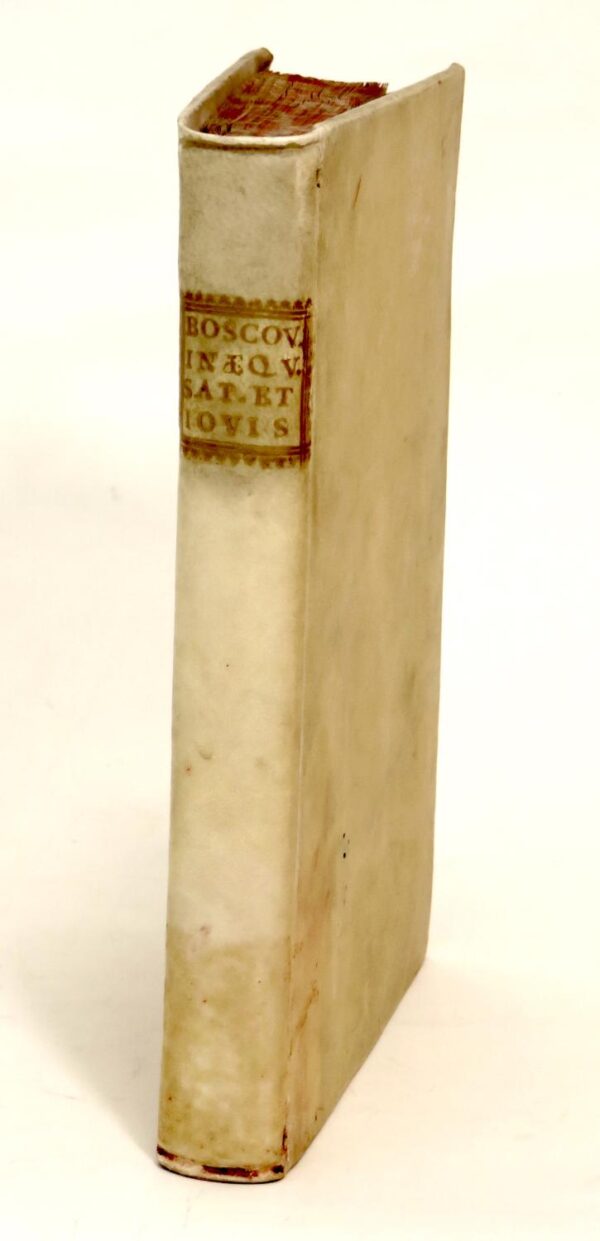
De inaequalitatibus quas Saturnus et Jupiter sibi mutuo videntur inducere praesertim circa tempus conjunctionis. Opusculum ad Parisiensem Academiam trasmissum et nunc primum editum .
BOSCOVICH, Ruggero Giuseppe] (1711-1787) 4to (200 x 127 mm), pp xxiv 187 [1], with woodcut ornament on title, woodcut initials and headpieces, and four folding engraved plates; a fine copy in contemporary Italian vellum, labelled in gilt on spine. First edition of Boscovich's work on the aberrations observed in the orbits of Saturn and Jupiter from the predicted Newtonian paths. Taking into account the Earth, this was a version of the classic three-body problem of determining the paths of three moving bodies which affect each other's gravitational field, and which has no rigourous algebraic solution, and requires approximation techniques.Isaac Newton had suggested in the second and third editions of his Principia (1713, 1726) that the observed perturbations in the motions of Jupiter and Saturn were a consequence of gravitational interaction, but neither he nor Flamsteed could devise equations to solve the problem. As a result the Paris Académie des Sciences had proposed a competition on solving the problem in 1748, 1750, and 1752, with Clairaut and d'Alembert acting as judges. They awarded the prize to Euler for the years 1748 and 1752, but the 1750 prize remained unassigned. Boscovich had submitted a paper on a proposed solution, which received an honourable mention and was considered for publication in the Mémoires of the Academy, but he wasn't awarded the prize. He decided to expand his paper, the result of which was the present work.Boscovich's approach arose from his study of comets and his method for determining parabolic orbits which, as DSB remarks, 'comes close to the classic method of H.W. Olbers (1797). An interesting treatise of 1749 concerns the determination of an elliptical orbit by means of a construction previously employed for resolving the reflection of a light ray from a spherical mirror. Boscovich employed this method again in 1756, in a treatise discussing the reciprocal perturbations of Jupiter and Saturn, which he entered in a competition on the subject set by the Academy of Sciences in Paris.'Riccardi I.1 179 n 9; Sommervogel I 1840 n 61- $5,000
- $5,000
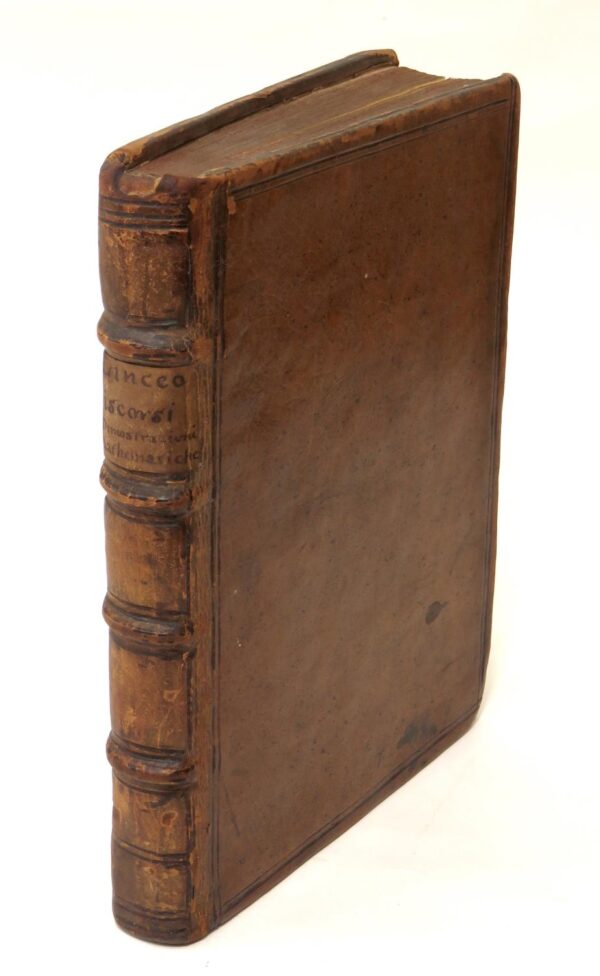
Discorsi e Dimostrazioni Matematiche, intorno à due nuove scienze Attenenti all mechanica & i movimenti locali . con une appendice del centro di gravita à d’alcuni solidi.
GALILEI, Galileo (1564-1642) 4to (190 x 137 mm), pp [viii] 306 [recte 314] [6], with numerous woodcut diagrams and illustrations in text; a very clean, crisp copy in untouched contemporary English blind-ruled sheep, paper label on spine, hinges slightly rubbed and small chip to head of spine. First edition of Galileo's most important work, the foundation of modern physics.This work was Galileo's 'greatest scientific achievement ? Mathematicians and physicists of the later seventeenth century, Isaac Newton among them, rightly supposed that Galileo had begun a new era in the science of mechanics. It was upon his foundation that Huygens, Newton and others were able to erect the frame of the science of dynamics, and to extend its range (with the concept of universal gravitation) to the heavenly bodies' (PMM 130). 'Unable to publish this treatise on mechanics in his own country because of the ban placed on his books by the Inquisition, he published it in Leyden. Considered the first modern textbook in physics, in it Galileo pressed forward the experimental and mathematical methods in the analysis of problems in mechanics and dynamics. The Aristotelian concept of motion was replaced by a new one of inertia and general principles were sought and found in the motion of falling bodies, projectiles and in the pendulum. He rolled balls down an inclined plane and thereby verified their uniformly accelerated motion, acquiring equal increments of velocity in equal increments of time. The concept of mass was implied by Galileo's conviction that in a vacuum all bodies would fall with the same acceleration. Newton said he obtained the first two laws of motion from this book' (Dibner).The book has a dedication to the Comte de Noailles, French ambassador to Italy, dated Arcetri, 6 March 1638, in which Galileo praised the publishers for their taste and skill. With all his writings banned by the Inquisition, Galileo had given the manuscript to De Noailles with instructions to have it published in Leiden by the Elseviers, to whom Galileo owed a debt of gratitude for the publicity given to his earlier writings, the Latin translations of the Dialogo and Letter to the Grand Duchess Christina published in 1635 and 1636.The binding is a typical 'cheap' English binding of the period, with no pastedowns, leaving the pasteboards showing.Provenance: eighteenth-century engraved Hopetoun bookplateCarli and Favaro 162; Cinti 102; Dibner 141; Evans 27; Horblit 36; Norman 859; Parkinson pp 80-81; PMM 130; Sparrow 75- $150,000
- $150,000
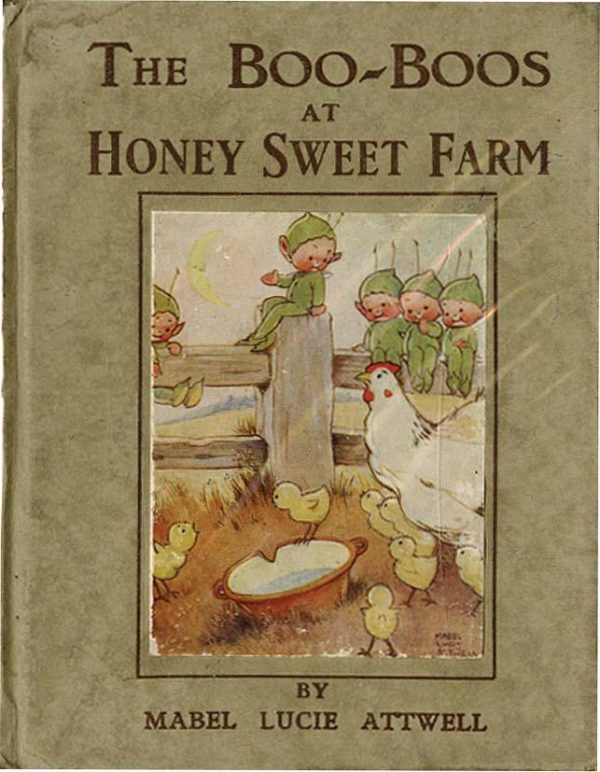
BOO-BOOS AT HONEY SWEET FARM
ATTWELL, MABEL LUCIE ATTWELL,MABEL LUCIE. THE BOO-BOOS AT HONEY SWEET FARM. Dundee, London, Montreal: Valentine, no date, circa 1921. 12mo (4 1/4 x 5 1/2"), boards, pictorial paste-on, slight shelf wear, VG-Fine. First edition. Illustrated by Attwell with pictorial endpapers, 14 color plates plus many full page and partial page green line illustrations all featuring a little girl named Bunty and Attwell's fairy Boo-Boos. Very scarce.- $1,100
- $1,100
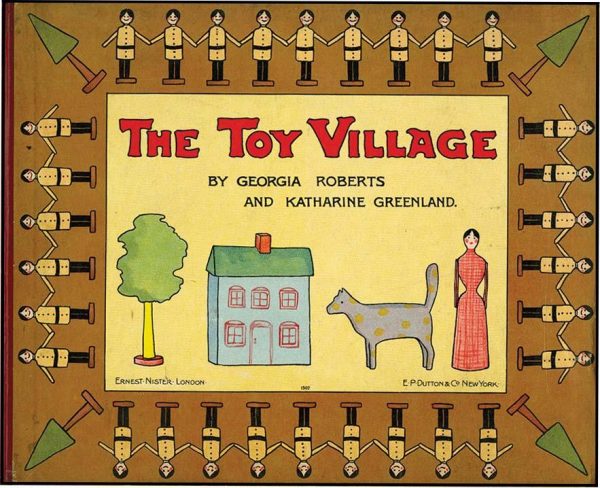
TOY VILLAGE
ROBERTS, GEORGIA PICTURE BOOK. THE TOY VILLAGE by Georgia Roberts. London & NY: Nister & Dutton, no date, circa 1906. Oblong 4to (11 1/4 x 9"), cloth backed pictorial boards, edges rubbed else VG+. This is a fabulous picture book with text in rhyme relating the tale of Noah and his crew after they came off of the Ark. Illustrated by Katharine Greenland with 20 full page chromolithographs portraying all of the characters as toys. See Peeps Into Nisterland p.281. This is a charming picture book.- $440
- $440
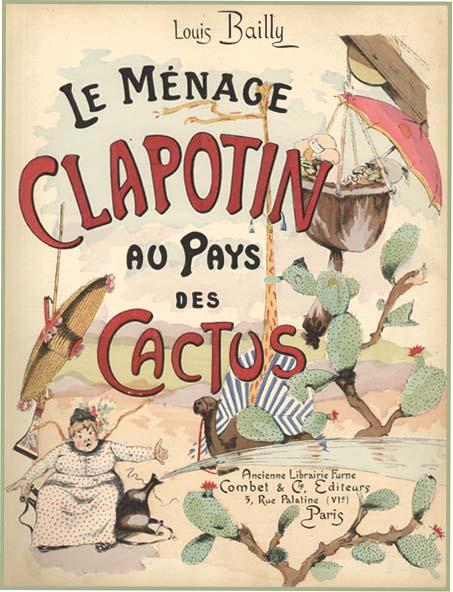
MENAGE CLAPOTIN AU PAYS DES CACTUS
BAILLY, LOUIS FRENCH. MENAGE CLAPOTIN AU PAYS DES CACTUS by Louis Bailly. Paris: Librarie Furne no date circa 1915. Folio, cloth backed pictorial boards, edges rubbed and new endpapers, VG. The adventures of Mr. Clapotin and his family when they travel to Tunis. Illustrated by noted artist Bailly with marvelous hand-colored illustrations throughout. See Dict. Des Illus. 1890-1945 p. 46-7.- $220
- $220
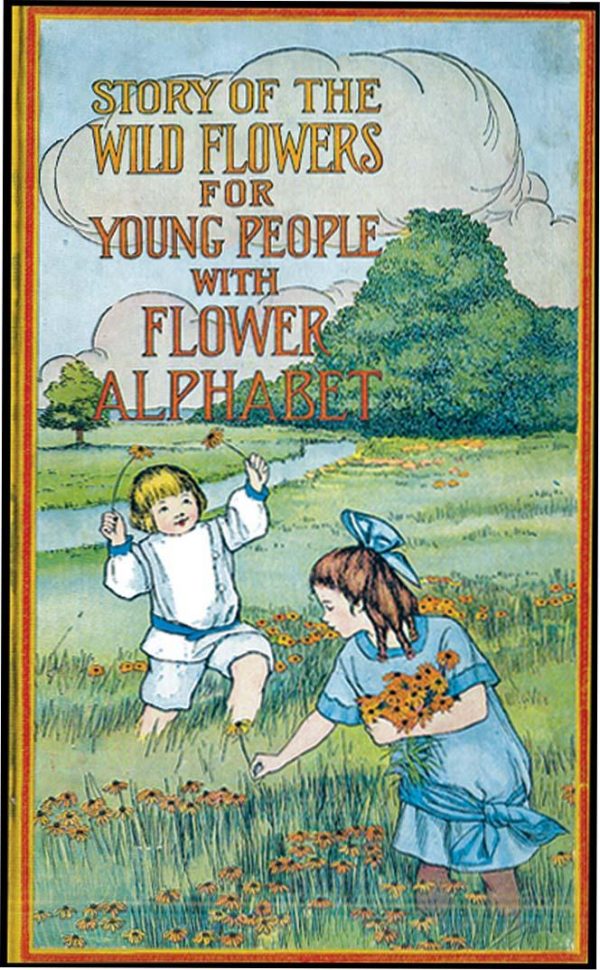
STORY OF THE WILD FLOWERS FOR YOUNG PEOPLE WITH FLOWER ALPHABET
KEELEY, GERTRUDE ABC. (FLOWERS) THE STORY OF THE WILD FLOWERS FOR YOUNG PEOPLE WITH FLOWER ALPHABET by Gertrude Keeley. NY: Hurst (1901, 1914). 4to (6 3/8 x 10 1/4"), cloth, pictorial paste-on, some slight cover soil else VG. Each of the 26 flowers from A-Z has 2 pages of text plus a poem, including some uncommon varities of flowers. Each letter is pictorially presented in color.- $165
- $165
![GRONNE SPILLEMAND [GREEN FIDDLER]](https://rarebookinsider.com/wp-content/uploads/2019/09/30422415003-600x446.jpg)
GRONNE SPILLEMAND [GREEN FIDDLER]
KALKAR (MOE,LOUIS)illus. DEN GRONNE SPILLEMAND [THE GREEN FIDDLER] by George Kalkar. Copenhagen: Henrik Koppels nd ca 1920's. Large obl. 4to, cl. backed pict. bds, light cover soil VG+. A fabulous book full of humanized insects, frogs and fairies. Illus., with 10 fine full page color plates and many detailed black and whites on text pages - similar to Elsa Beskow in style. A great picture book.- $220
- $220
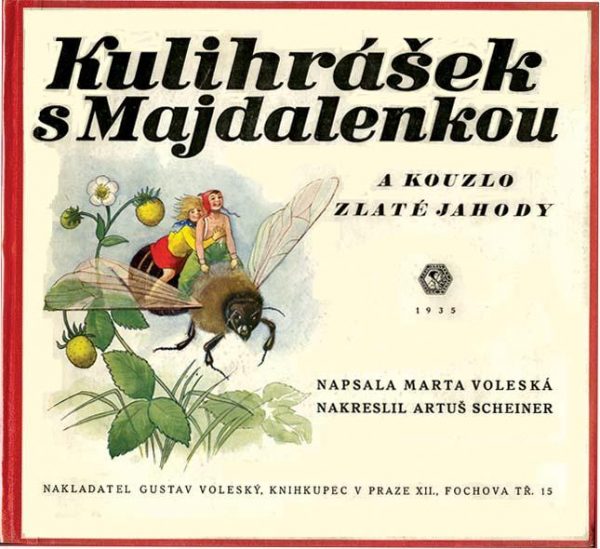
KULIHRASEK S MAJDALENKOU
VOLESKA, MARTA CZECHOSLOVAK. KULIHRASEK S MAJDALENKOU verse by MartA Voleska. Praze: Gustav Volesky 1935. Oblong 4to (10 3/4 x 9 3/4"), cloth, pictorial paste-on, slight bit of cover soil, VG+. This is the fantasy trip of two little children who shrink to the size of insects and have adventures with the insect world. Beautifully illustrated by noted Czech artist ARTUS SCHEINER with bold colors on every page. See Illus. of Children's Books v.1 p. 136, 145 for others by Scheiner.- $220
- $220
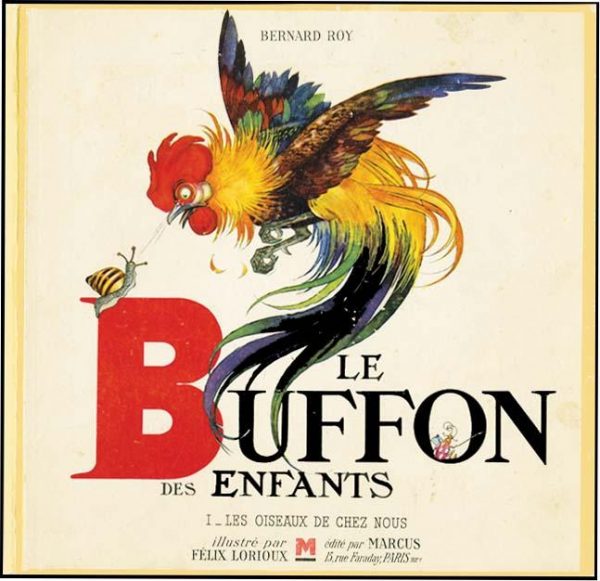
LE BUFFON DES ENFANTS: LES OISEAUX DE CHEZ NOUS
ROY, BERNARD (LORIOUX,FELIX)illus. LE BUFFON DES ENFANTS: LES OISEAUX DE CHEZ NOUS by Bernard Roy. Paris: Marcus (1946). Square 4to (10 x 10"), pictorial boards, slight edge rubbing, near fine. Featuring the most absolutely stunning full page color illustrations by Lorioux of birds (rooster, stork, owl, peacock, pelican etc.) accompanied by his detailed and humorous humanized animals and insects. Beautifully printed with rich colors including pictorial endpapers.- $330
- $330
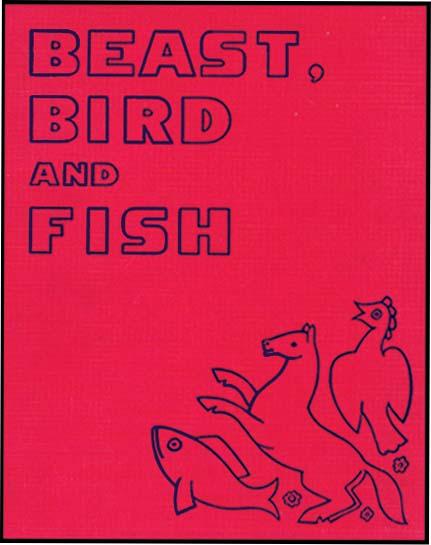
BEAST, BIRD AND FISH
MORROW, ELIZABETH MORROW,ELIZABETH. (D'HARNONCOURT,RENE) BEAST, BIRD AND FISH by Elizabeth Morrow. NY: Alfred A. Knopf 1933 (1933). 4to (8 1/4 x 13 3/4"), pictorial cloth, some cover soil else VG+, no dust wrapper. Stated 1st edition. This is an animal alphabet book with text presented in verse and including musical notation. Every letter has a very beautiful full page color illustration by RENE D'HARNONCOURT in his distinctive folk-peasant style and with his use of flat colors. A perfect alphabet book by the collaborators of the Painted Pig (Morrow was Anne Morrow Lindbergh's mother and wife of the American ambassador to Mexico). THIS COPY IS INSCRIBED BY ELIZABETH MORROW. Bader p.71. Very scarce.- $440
- $440
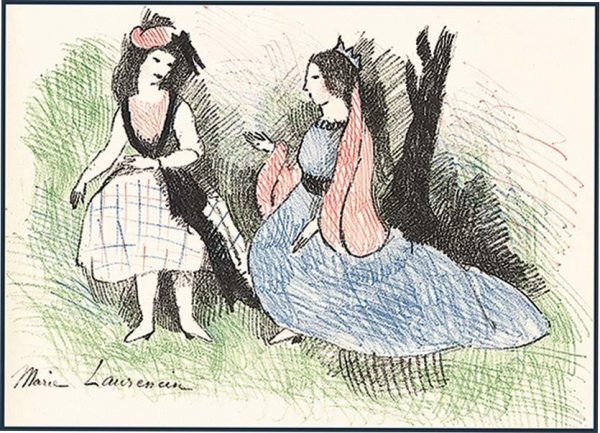
ALICE IN WONDERLAND
CARROLL, LEWIS CARROLL,LEWIS. (LAURENCIN) ALICE IN WONDERLAND. Paris: Black Sun Press 1930. Oblong 4to, white wraps, 114p., VERY FINE IN ORIGINAL GLASSENE, CHEMISE AND SLIPCASE (case scuffed with some minor wear and soil). LIMITED TO ONLY 370 COPIES FOR EUROPE, this is one of the 50 copies PRINTED ON JAPANESE VELLUM. Illustrated by MARIE LAURENCIN with 6 magnificent color plates. Quite scarce and a beautiful copy of a most desired book.- $5,500
- $5,500
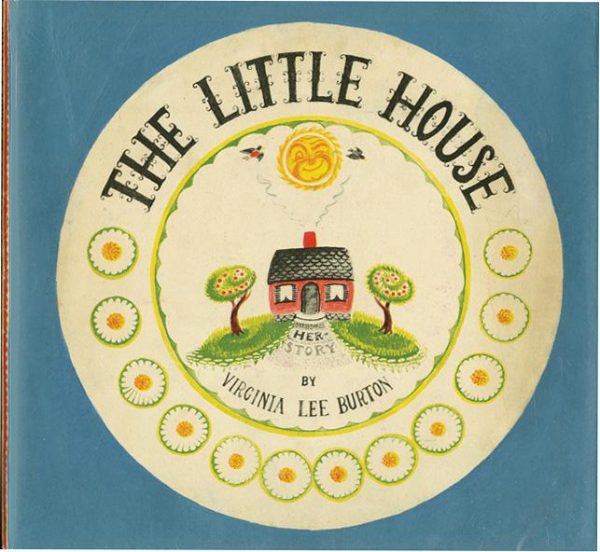
LITTLE HOUSE
BURTON, VIRGINIA LEE BURTON,VIRGINIA LEE. THE LITTLE HOUSE. Boston: Houghton Mifflin 1942 (1942). 4to (9 3/4 x 9"), pictorial cloth, Slight soil on top edge of cover else a clean, Fine copy in a fabulous dust wrapper (some practically undetectable small bits of restoration of dw). 1st edition (1st printing) of one of the rarest CALDECOTT AWARD WINNERS. and a children's classic. The story relates the conflict between an ever changing city life and tranquil country life, beautifully illustrated with color lithographs by Burton. See Bader p.201-2. Nice copies like this are very hard to find.- $12,650
- $12,650
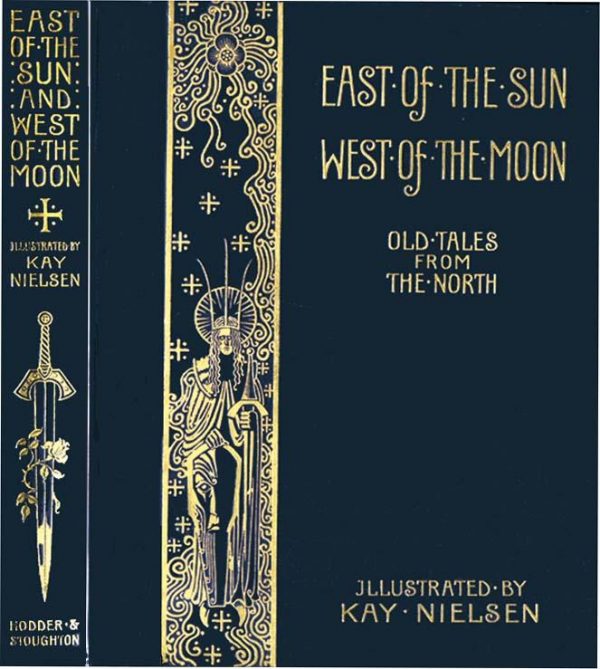
EAST OF THE SUN AND WEST OF THE MOON
(NIELSEN,KAY)illus. EAST OF THE SUN AND WEST OF THE MOON. [London] Hodder & Stoughton, no date [1914]. Large 4to, (9 x 11 1/2"), blue cloth with extensive gilt decoration - a Very Fine copy with gilt bright. 1st edition of Nielsen's most desired book, illustrated with pictorial endpapers and featuring 25 magnificent tipped-in color plates with lettered guards as well as numerous detailed black and whites throughout the text. A beautiful copy of the first edition.- $4,950
- $4,950
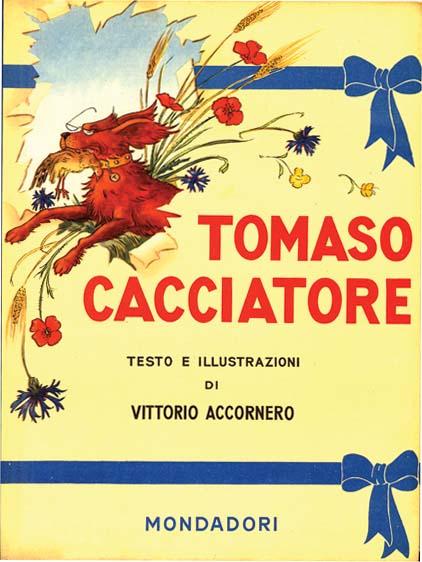
TOMASO CACCIATORE
ACCORNERO, VITTORIO ITALIAN. TOMASO CACCIATORE testo e illustrazioni di Vittorio Accornero. Arnaldo Mondadori (1950). 4to, cloth backed pictorial boards, near fine in dw with tape mends. A dog and bunny tale set at Christmas time and illus. by the author with wonderful full and partial page color lithos.- $165
- $165
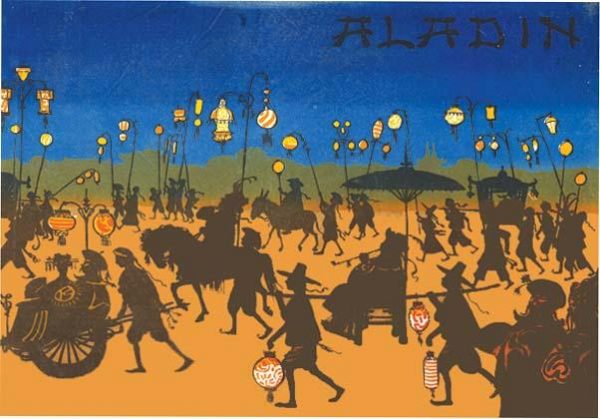
ALADIN: OMBRES CHINOISES EN QUINZE TABLEAUX
METIVET, LUCIEN ALADDIN. ALADIN: OMBRES CHINOISES EN QUINZE TABLEAUX poeme & images de Lucien Metivet. Paris: Flammarion (1904). Large obl. 4to, pict. boards, FINE IN PICTORIAL DUSTWRAPPER! Music for a theatrical production of Aladin is provided by Jane Vieu. The book is illustrated with magnificent, richly colored lithographs by LUCIEN METIVET - both full and partial page. The style and images are Chinese. This is a beautiful copy, rare in the pictorial dustwrapper which has served to preserve the pictorial cover. See Dictionaire des Illustrateurs 1800-1914 p.694 for entry on Metivet. A great picture book.- $550
- $550
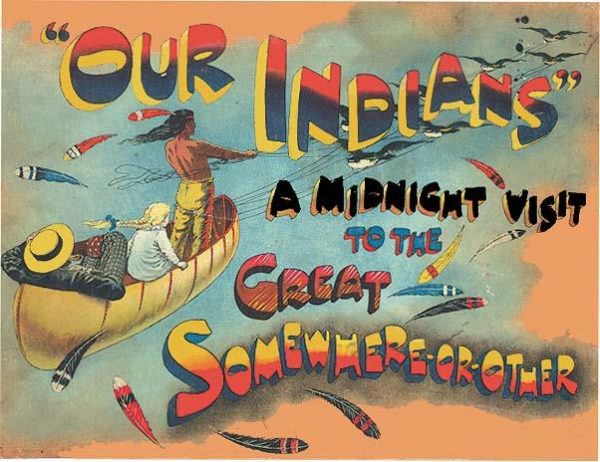
OUR INDIANS: A MIDNIGHT VISIT TO THE GREAT SOMEWHERE-OR-OTHER
BRADLEY, LUTHER DANIELS BRADLEY,LUTHER DANIELS. OUR INDIANS: A MIDNIGHT VISIT TO THE GREAT SOMEWHERE-OR-OTHER. [NY]:Dutton 1899. Oblong large 4to, cl. backed pictorial boards, edges lightly rubbed light wear to front endpaper else a near fine, tight clean copy of this rare book. With text written in verse, the story is a dream fantasy trip taken by a little girl and boy (the girl based on Bradley's niece). They slip out at night in a flying canoe guided by an Indian who takes them to a quiet land of peace and harmony. Featuring striking full page chromolithographs (16 full page and 5 double page) - the artwork by Bradley as well. Luther Daniels Bradley, educated at Yale, was an editorial cartoonist for the Chicago Daily News. In Image and Maker p.26-36 Helen Borgens notes : "Our Indians is a personal dream vision. Bradley depicted the Indians as expressing the qualities inherant in all human beings." yet he juxtaposed this realism with absurd images of Indians serving tea in china cups or performing a vaudeville act with band instruments to celebrate a victory. It is the combination of real and surreal that gives this book its unique quality. About the artwork, Borgens says that "the symmetry of individual illustrations reinforces the symmetry of the entire book." Altogether a wonderful book, quite rare and when found it is usually in terrible condition.- $1,320
- $1,320
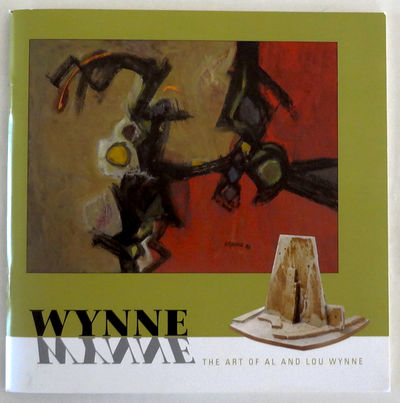
Wynne. The Art of Al and Lou Wynne
Felix, Tracy. Co-Curator Denver, 2008 Denver: Kirkland Museum of Fine & Decorative Art, 2008. First Edition. Staplebound wraps. Very good. Catalog of the exhibition of fine art and pottery by Al and Lou Wynne held at the Kirkland Museum of Fine Art, Denver from Oct. 1, 2008 through Jan 4, 2009. Stapled pictorial wraps. 8" x 8" 56pp. Very good condition. Al Wynnes work has been featured in major exhibitions from Colorado to Washington D.C., south to Texas and north to Alaska. His work has been presented in both individual and group shows. Paintings, calligraphy, and sculptures are held in museums and in private collections around the world. Al was listed in Whos Who in American Art starting in 1959. In June 2013, the majority of Al's life's work was destroyed in the Black Forest Fire. All that remains are pieces held by the family and in collections.- $125
- $125
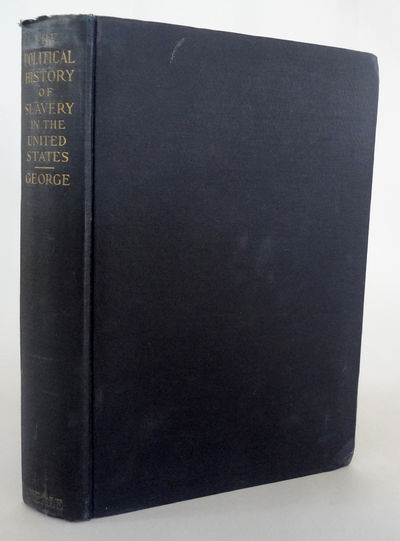
Political History of Slavery in the United States.
George, James Z. New York, 1915 New York: The Neale Publishing Company, 1915. First Edition. Hardcover. Very good. 8vo. Dark blue cloth with title, author and publisher in gold on the spine. This copy presented to his friend Col. Dillingham by William Hayne Leavell, United States Envoy Extraordinary Guatemala, who wrote the books foreword and financed its publication. Laid in is a handwritten letter from Leavell to Dillingham on paper embossed "Legation of the United States of America".Very good with minor foxing to last few pages and light shelf wear to cover.- $400
- $400
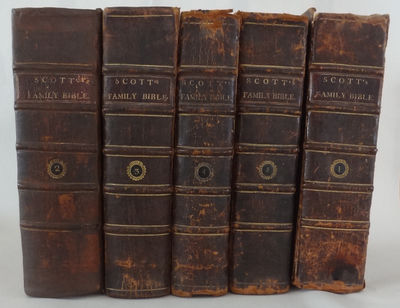
The Holy Bible Containing The Old and New Testaments, with Original Notes, Practical Observations, and Copious Marginal References
Scott, Thomas Philadelphia, 1804 Philadelphia: William W. Woodward, 1804. First American Edition. Full leather. Good. First American, From the Second London Edition. Complete in five volumes, with original cloth backed map accompanying the five. Contemporary full leather with five raised bands and dark red lettering piece to spines. Contains family history of the Thompson - Howell family of New York. Covers a little rubbed. Some toning and occasional foxing. A half page of family history excised. Hand colored "Map of Palestine or Holy Land from the Best Authorities" Engraved for Whiting & Watson's edition of Dr. Scott's Bible by Peter Maverick, Newark shows toning with some foxing.A fine example of a very early American printed Bible.- $1,250
- $1,250
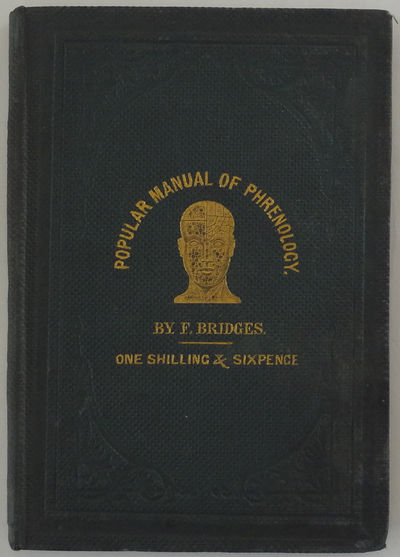
Popular Manual of Phrenology
Bridges, Frederick London, 1860 London: George Philip and Son, 1860. First Edition. Hardcover. Good. Small 8vo. 96pp. Green pictorial embossed cloth over boards. Light tanning throughout and old stain to rear end papers.A seemingly scarce volume on phrenology, a pseudo-medicine primarily focused on measurements of the human skull, based on the concept that the brain is the organ of the mind, and that certain brain areas have localized, specific functions or modules. Although both of those ideas have a basis in reality, phrenology extrapolated beyond empirical knowledge in a way that departed from science.- $100
- $100
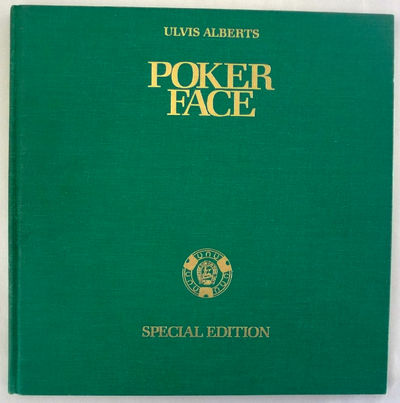
Poker Face
Alberts, Ulvis Hollywood, 1981 Hollywood: Angel City Books, 1981. Limited Edition. Hardcover. Good. Special edition number 80 of 500 boldly signed by Alberts. Large square quarto hardcover. Gilt stamped green cloth with matching slip case. Book in very good condition with a little rubbing to spine. Slip case mottled and partially split on two edges. In the 1970's, there was only one tournament game the professional gamblers waited for all year and that was the "World Series of Poker" at Binion's Horseshoe casino in downtown Las Vegas. Alberts photographs of these events and his candid pictures of legendary players, including Johnny Moss, "Amarillo Slim" Preston, Stu Unger, Jack "Treetop" Strauss, Doyle Brunson, Benny Binion and many others, form the story of those iconic early years.- $2,000
- $2,000
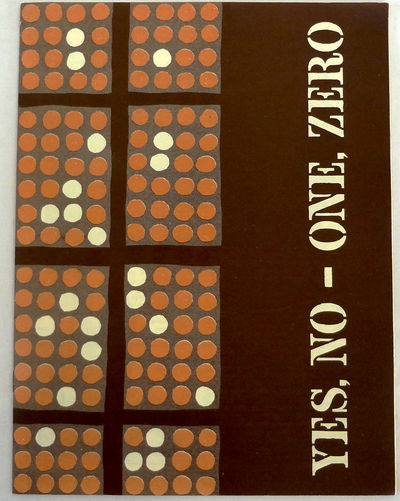
Yes, No – One, Zero
Esso Standard New York, 1958 New York: Esso Standard, Division of Humble Oil & Refining Company, 1958. First Edition. Staplebound wraps. Near fine. Staple bound wraps. 15pp paginated in binary number system 0010 to 1111. 10 1/2" by 8". Fine condition.Prepared by the publisher for teachers in the nine states that Esso had offices this booklet provides an explanation of the binary system as a language for early computers and also asks questions such as "What are these devices? In what sense do they think? Will they replace the human brain? A fascinating glimpse into early electronic computer technology.- $125
- $125
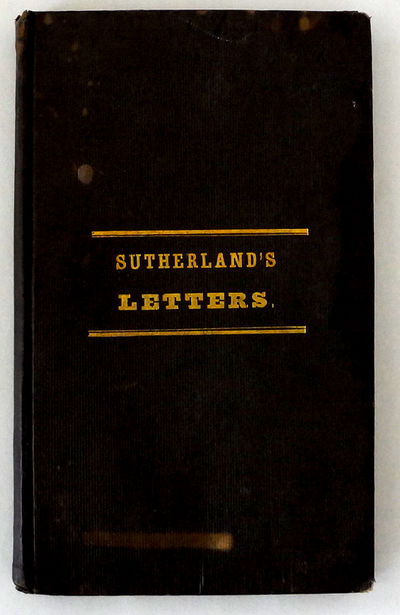
A Letter to her Majesty the British Queen
Sutherland, Th. Jefferson Albany, 1841 Albany: Printed by C. Van Benthuysen, 1841. First Edition. Hardcover. Good. New York imprint concerning the Canadian Rebellion, noted for it's index of captive patriots imprisoned at Van Dieman's Land. 168pp in gilt titled brown cloth binding, areas of fade, lightly foxed endpapers showing dampstain. Otherwise neat, tidy.- $1,250
- $1,250
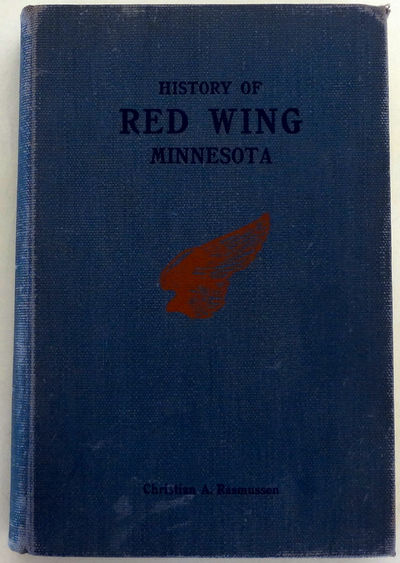
A History of the City of Red Wing Minnesota
Rasmussen, Christian A. Red Wing, Minnesota, 1934 Red Wing, Minnesota : Red Wing Advertising Co, 1934. First Edition. Hardcover. Very good. 8vo [viii] 296pp + 16 plates. Blue cloth with dark blue lettering end red design. Previous owner's name to front free end paper otherwise clean throughout. Tight binding. Some wear to cover with some rubbing to spine.- $125
- $125
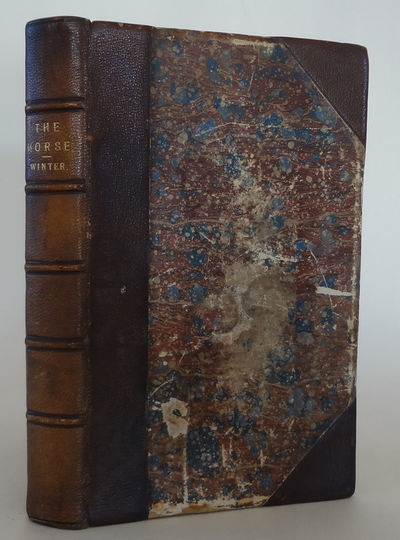
The Horse in Health And Disease; or, Suggestions on His Natural and General History, Varieties, Conformation, Paces, Action, Age, Soundness, Stabling, Condition, Training and Shoeing With a Digest on Veterinary Practice.
Winter, James W. London, 1846 London: Longman, Brown, Green, and Longmans., 1846. First Edition. Hardcover. Good. Quarter bound brown leather over marbled boards. 8vo. Frontispiece [viii] pp 376 with nine b/w plates and one color plate. The author, James W. Winter was a member of the Royal College of Veterinary Surgeons, and of the Association Litteraire D'Egypt and late Veterinary Surgeon to Mehmet Ali and Ibrahim Pasha.Overall good condition with some wear to the boards and light moisture marks to the plates. Two page corners professionally repaired. back free endpaper excised.- $500
- $500
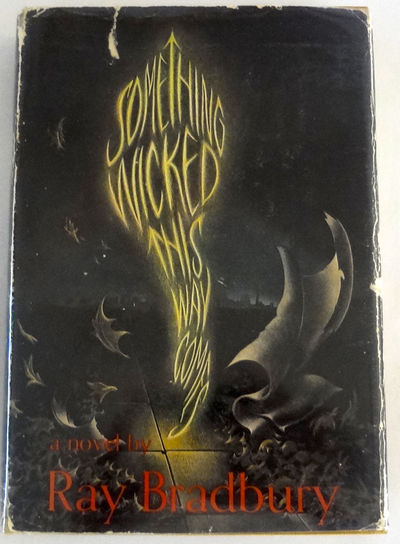
Something Wicked This Way Comes
Bradbury, Ray New York, 1962 New York: Simon and Schuster, 1962. First Edition. Hardcover. Very good/fair. Stated 1st printing. Mustard colored boards with black lettering. Red top stain. Book in very good condition. Dust jacket shows heavy wear to edges with some closed tears. Original $4.95 price present.- $300
- $300
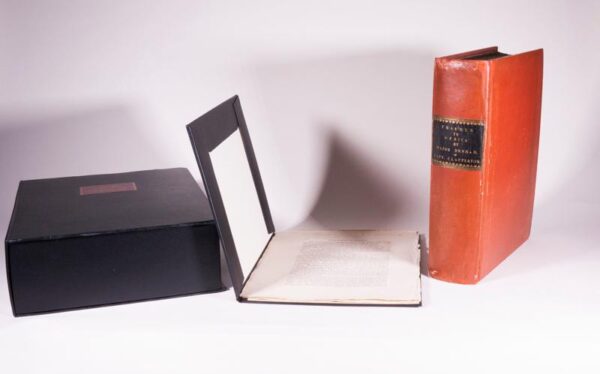
Narrative of Travels and Discoveries in Northern and Central Africa, in the Years 1822, 1823 and 1824, by Major Denham, Captain Clapperton and The Late Doctor Oudney, Extending Across the Desert to the Tenth Degree of North Latitude, and from Korika in Bornou, to Sackatoc, The Capital of The Fellatah Empire. With and Appendix.
Denham, Dixon and Clapperton, Hugh London: John Murray, 1826. 1st Presentation Edition, Signed. Royal 4to -- 29.4cm. [lxviii], 336pp., [iv], 272 pp., Appendix. Two volumes in one. Original Tuscan-red boards, spine with a fine contemporary black morocco label, tooled and titled in gilt; with 37 fine engraved and etched plates, charts and maps, and one large fold-out map, of which 35 full-page plates are on India paper, mounted and, of which 28 are also present in 2nd state for a total of 63 plates in all, comprising a Proof State Before Letters, and also on India paper, mounted, wood-engraved illustrations. Binding is professionally re-backed with old spine laid down, inner hinges restored. Now contained in a specially constructed black solander box with integral flap-case -- NB: As a result of a binders error, this copy was bound without four leaves (signature C of Volume II) and noted at the time on the original incorrectly bound signature in a contemporary graphite hand: This is a mistake. These have been supplied from another copy of the first edition. A Very Good copy of the one of the most sought after issues of this masterpiece of African travel. Presentation Copy of the First Edition inscribed on the front free-endpaper, John Major from the Publisher. Lowndes: The most interesting and important work yet published on the subject of African researches. It is written in a plain and perspicuous style, and containing many particulars of an hitherto unknown country. This, one of very few copies printed upon thick paper for presents only. According to Lowndes, there were 2 lesser issues of the first edition: the regular issue; a special issue, with the plates mounted on India paper; and third issue for presents only (op.cit.) the issue that is listed here, which has the plates mounted on India paper. The engravings, after original drawings by Denham and Clapperton, are superbly engraved by Edward Finden, one of the finest steel-engravers in England at the time. Denham and Clapperton, in the company of Dr. Walter Oudney, travelled from Benioleed, near Tripoli, almost due south to Lake Tchad, with excursions in the mountains west of Mourzuk in Fezzan. Dixon attempted to follow the circuit around Lake Tchad but was unsuccessful. In the meantime, Clapperton and Oudney journeyed west from the lake toward the Niger River, but the doctor only made it about a third of the way, and died in Murmur. Clapperton continued west, but was prevented from passing beyond Sackatoo by the local Sultan. He and Dunham subsequently returned to Tripoli and crossed back to England. This exciting narrative is compiled from Denhams journal, with a chapter by Dr. Oudney on the excursion to the mountains west of Mourzuk. A final section by Clapperton relates to the westward journey form Lake Tchad to Sackatoo and includes an account of Oudneys death. Among the several appendices are translations from the Arabic or various letters and documents brought back by Denham and Clapperton, including a document relating to The Death of Mungo Park; a translation from Arabic of A Geographical and Historical Account of The Kingdom of Tak-roor, from a larger work composed by Sultan Mahommed Bello of Hausa; Vocabularies of Bornou, Begharmi, Mandara and Timbuctoo; appendices on the Zoology and Botany of the Regions based on samples collected by Dr. Oudney; a note on Rock Specimens; and a Thermometrical Journal kept at Kouka in Bournou. -- Lownnes I p. 629, Howgego D18 Vol. II.- $3,800
- $3,800
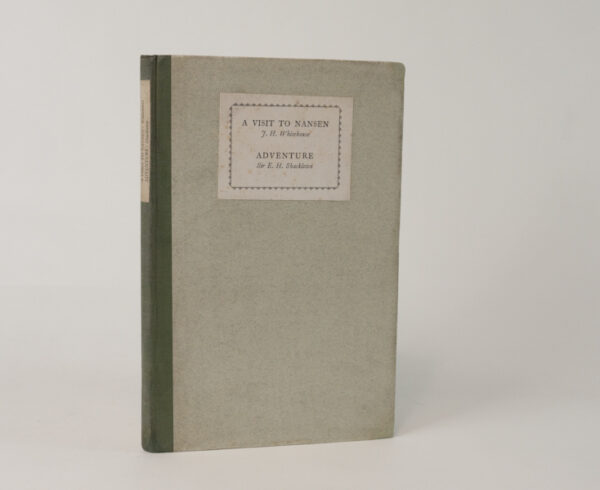
Adventure & A Visit to Nansen: Essays by Ernest Shackleton & Fridtjof Nansen
Whitehouse, JH London: Oxford University Press, 1928. 1st Edition. Adventure by Ernest Shackleton & A Visit to Nansen. 8vo, 22.7cm, [2], 23pp [5]. In Near Fine publishers green cloth backed boards with green cloth back strip, upper cover and spine with publishers paper labels lettered in black, two portrait front pieces. Uncut page edges. Near Fine condition internally with tight un-cracked hinges and no prior ownership markings. Scarce. This unique copy is signed by JH Whitehouse on a private library label inside the front cover. Spence 1255; Taurus 132; Renard 1691; Rosove 1343. The significance and importance of this publication to Antarctic exploration lies in the article by Ernest Shackleton entitled Adventure where he describes the spirit that moved him to explore. A well-written and interesting pair of essays by two of the most notable and accomplished polar explorers in the 19th and 20th centuries.- $450
- $450
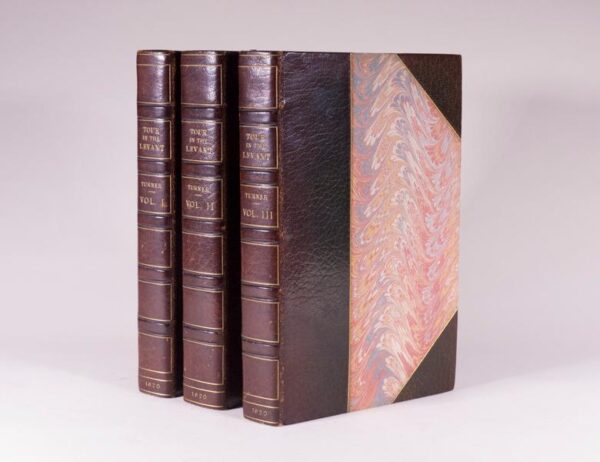
Journal of a Tour in the Levant
Turner, William Esq. London: John Murray, 1820. First Edition. Complete in 3 volumes. 8vo 22.7cm. 22 engraved plates of which 6 are hand-coloured aquatints - 2 of which are fold-out panoramas and one being a double-sided facsimile, 2 fold-out engraved maps, illustrations in text. All half-titles and coloured frontis piece plates are present. Volume I: [xxiii], (2), 408pp. (1); Volume II: [vi], (1), 608pp - incl. Appendix; Volume III: [vi], (1), 546pp incl. Index, (1-Errata), (1). Later half burgundy morocco with marbled boards and matching marbled end leaves, top page edges gilt, spines with five compartments ruled in gilt with bright gilt titles. Bound by Worsford. A very attractive set inside and out. Near Fine+ and complete. Scarce. First edition of this important work, which contains the accounts of several journeys, not consecutive. Turner spent five years in the Levant with this being a fascinating record of the Levant in the early nineteenth century. Turner's travels, while he was attached to the British embassy at Constantinople, took him to Egypt, the Holy Land, Albania, Greece and numerous Greek islands, as well as Turkey. The plates show costumes and antiquities, as well as views of Smyrna, Patmos and Pergamus. Atabey 1251, Blackmer 1687, Weber 94.- $7,500
- $7,500
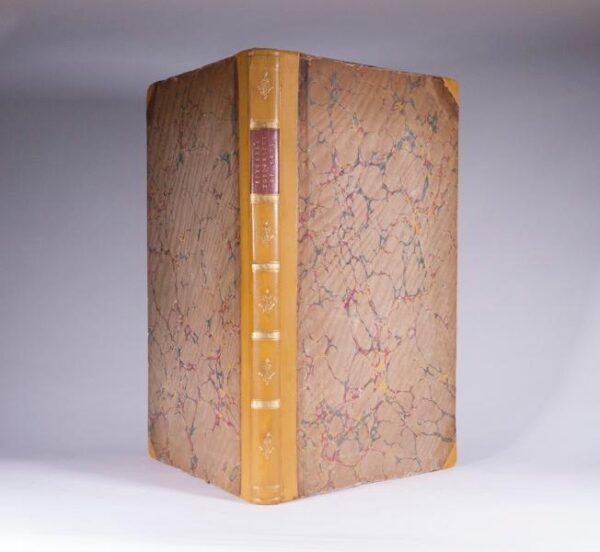
Topography of Troy, and Its Vicinity Illustrated and Explained by Drawings and Descriptions. Dedicated by Permission, to her Grace The Duchess of Devonshire.
Gell, William Inscribed and Signed by Lord Byron. London: C. Whittingham, for T.N. Longman and O. Rees, 1804. First Edition. Folio 43.5cm. (iv), 124 pp. Title leaf with hand-coloured engraved vignette, dedication leaf, 28 hand-coloured plates including 3 fold-out plates and 2 hand coloured maps, 13 engravings in the text, all but 2 coloured -- the entire sequence numbered 1--45, one unnumbered plate at page 21. ¾ tan calf with red morocco spine label and bright gilt decorations on spine. A lovely and complete copy in Near Fine Condition. Rare. The production of this very handsome folio was intended to provide accurate illustrations of the scenery covering the whole region of Troy. William Gell visited the Troy in December, 1801 during his first trip to Greece. He used a camera lucida (an instrument in which rays of light are reflected by a prism to produce on a sheet of paper an image, from which a drawing can be made) to produce in a very short time extremely accurate small-scale sketches of vast landscapes and scenes. The final production of this very handsome folio with its forty-five plates was meant to supply accurate illustrations of the scenery covering the whole region of Troy. This is a very impressive publication. Travel, 399. Blackmer Library 660. Certainly the most beautiful book on Troy ever printed --A.K. Lascarides, The Search for Troy, 1553-1874, 1977 Inscribed and Signed by Lord Byron on the verso of the second blank front free leaf reading: Sir William Gells Topography of Troy cannot fail to insure the appreciation of every man possessed of a classical taste as well for the information. Sir W. conveys to the mind of the reader as for the ability & research the works display. Ld. Byron- $7,000
- $7,000
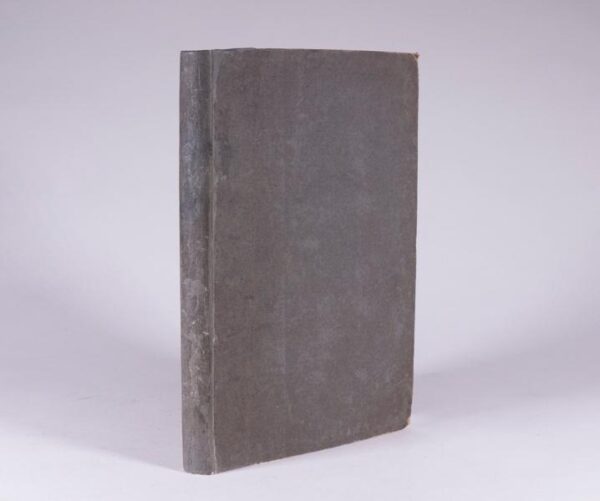
The Importance of the Cape of Good Hope, As a Colony to Great Britain, Independently of the Advantages it Possesses as a Military and Naval Station, and the Key to Our Territory Possession of India.
Fisher, Richard Barnard London: T. Cadell and W. Davies, 1816, First hardbound edition. 3rd (and best) edition with additions. 8vo 22.7cm. [xxiv], 190 pp. Fold-out hand-colored aquatint frontispiece, fold-out hand-colored plan in outline. Original boards re-backed with original spine laid down and original endpapers. A very clean and complete copy with no foxing and pages untrimmed. The first two editions of the work were issued in pamphlet form, and the present volume possesses additions to the letterpress of earlier productions. Fisher was of the opinion that the Hottentots had no language and that the few words they pronounced were either Portuguese or Dutch. Fisher complains that there were no taverns, hotels, or even shops in Cape Town, and draws a by no means favorable picture of it inhabitants, who he says, have a most inordinate sense of pride while they seem to pride themselves on their dexterity in imposition, and none suffer so much from it as English military and navy. He also quotes Barrow as saying that the inanity of their minds and the indolent habit of their bodies are not even surmounted by self-interest, and reference is made to the extreme brutality displayed by the Africans (Afrikanders) to their slaves. There is an article on the wines of the colony, and others having reference to the trade in dried fruits, ostrich feathers, ivory, &c. Under the title Further Considerations, many suggestions are made for the betterment of the government of the colony Mendelssohn Volume 1. Pp. 547.- $3,500
- $3,500
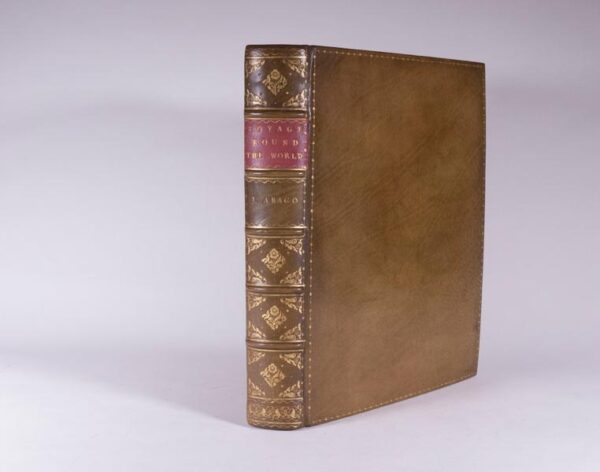
Narrative of a Voyage Round the World, in the Uranie and Physicienne Corvettes, Commanded by Captain Freycinet, During the Years 1817, 1818, 1819 and 1820; on a Scientific Expedition Undertaken By Order of the French Government, in a Series of Letters to a Friend
Arago, Jacques London: Treuttel and Wurtz, Treuttel, Jun. and Richter. 1823, First English Edition. Quarto 27.5 cm. 2 parts in 1, fold-out frontispiece map and 25 lithograph plates -- complete; later full-tan calf with gilt decorative ruled border on front and rear boards, spine with five raised bands, bright gilt decorative compartments and fuchsia morocco title label. Despite the clear evidence of the 'Directions for placing the Plates' present here, there has been some unnecessary confusion about the collation of this book. Ferguson omitted the map from his plate count, while Hill erroneously called for a map and 26 plates. This very clean copy, with the map and 25 plates is complete and in Near Fine+ condition. The first edition in English of this private narrative of the 1817-1820 Freycinet expedition to Australia and the Pacific - in fact the first appearance in English of any account of the voyage. Originally published in French, Arago's book in its many subsequent editions became one of the voyage best-sellers of the nineteenth century. The English edition is much rarer than the French edition. The very large multi-volume French account of the voyage was far more serious and scientific in tone. Arago was the official draftsman on the voyage, and the excellent lithograph plates here are all after Aragos drawings. WITH: A 3-page letter written and signed by Arago dated 8 April 1842 to Minister M. Piobert discussing the voyages of Dumont Durville and La Place. The Uranie with a crew of 125 men under the command of Captain Louis de Freycinet, entered the Pacific from the West to make scientific observations on geography, magnetism and meteorology. Arago was the artist of the expedition which visited Western Australia, Timor, Hawaii and New South Wales. The original ship wrecked off the Falkland Islands. Two months later, the expedition continued aboard the Physicenne which stopped for a time in Rio de Janeiro. Captain Freycinets wife, Rose Pinon, was smuggled on board at the advent of the voyage and made the complete journey, causing some discord among the crew. Freycinet named an island he discovered after her Rose Island among the Samoa Islands. These entertaining letters, written in a lively and witty literary style, provide vivid descriptions of the topography and the inhabitants of the Pacific Islands. The book achieved great success. Hill 28-29.- $8,500
- $8,500
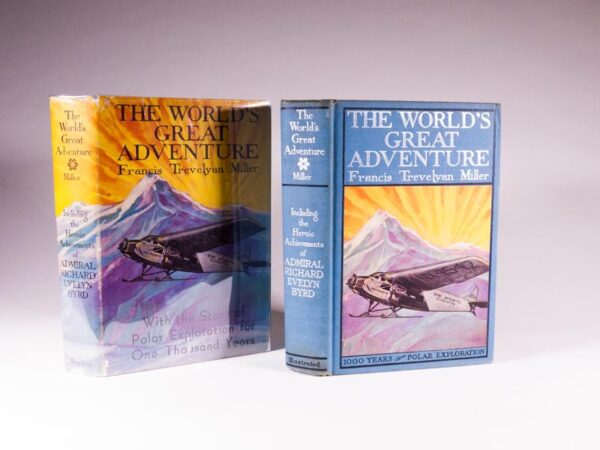
The World’s Great Adventure 1000 Years of Polar Exploration – Including the Achievements of Admiral Richard Evelyn Byrd. with Forewords by General A.W. Greely and Dr. Henry Fairfield Osborn. Signed by Lawrence Gould and John OBrien
Miller, Francis Trevalyan, LL.D., Litt.D. Philadelphia, Chicago and Toronto: The John C. Winston Company, 1930. 1st Edition. 8vo 22.4cm. 384pp. Flights for the Top of the World and detailed Chronology of Explorations at the rear; illustrated with a colored frontispiece and black-and-white photographs and drawings. Publishers blue cloth with colored cartographic end leaves of the north and south polar regions. Silver tiles and color image on front cover are bright, spine silver also bright; very light wear to extremities. A Near Fine and complete copy in a lovely unclipped dust jacket in Very Good condition. This unique copy is signed twice. On page 63, the full-page black-and-white photographic plate of Lawrence Gould is signed by him. Gould was second in command of Byrds expedition and served as expedition geologist. On page 76, the full-page photographic plate of John OBrien is signed by OBrien. He served as chief surveyor and Assistant to Admiral Byrd on the Byrd Antarctic Expedition. The book presents a well-researched history of polar expeditions, by Admiral Byrd and many others.- $200
- $200
![Bland Tomtar och Troll 8 [Among Gnomes and Trolls]](https://rarebookinsider.com/wp-content/uploads/2019/12/30458152133.jpg)
